SEO
12 Things That Only Ahrefs Can Do

What makes Ahrefs better than the competition?
It’s a fair question but a tough one to answer because there are just so many things to compare.
So instead of filling out one of those classic “us” vs. “them” comparison tables, we decided to go a different route and showcase some of Ahrefs’ unique features and functionalities.
Note
These features were selected by comparing Ahrefs to other similarly priced all-in-one SEO tools. It’s quite possible that some of the lesser-known, more specialized SEO tools have one or more of these features.
With Ahrefs, it’s possible to specify an exact date when working with historical data. This opens up the space for a handful of actionable use cases.
The first use case is to access the Organic keywords report to see how ranking fluctuations have affected search traffic over time.
For example, going up three ranking positions for the keyword “affiliate marketing” has brought us ~3,000 more search visits in a matter of three months.
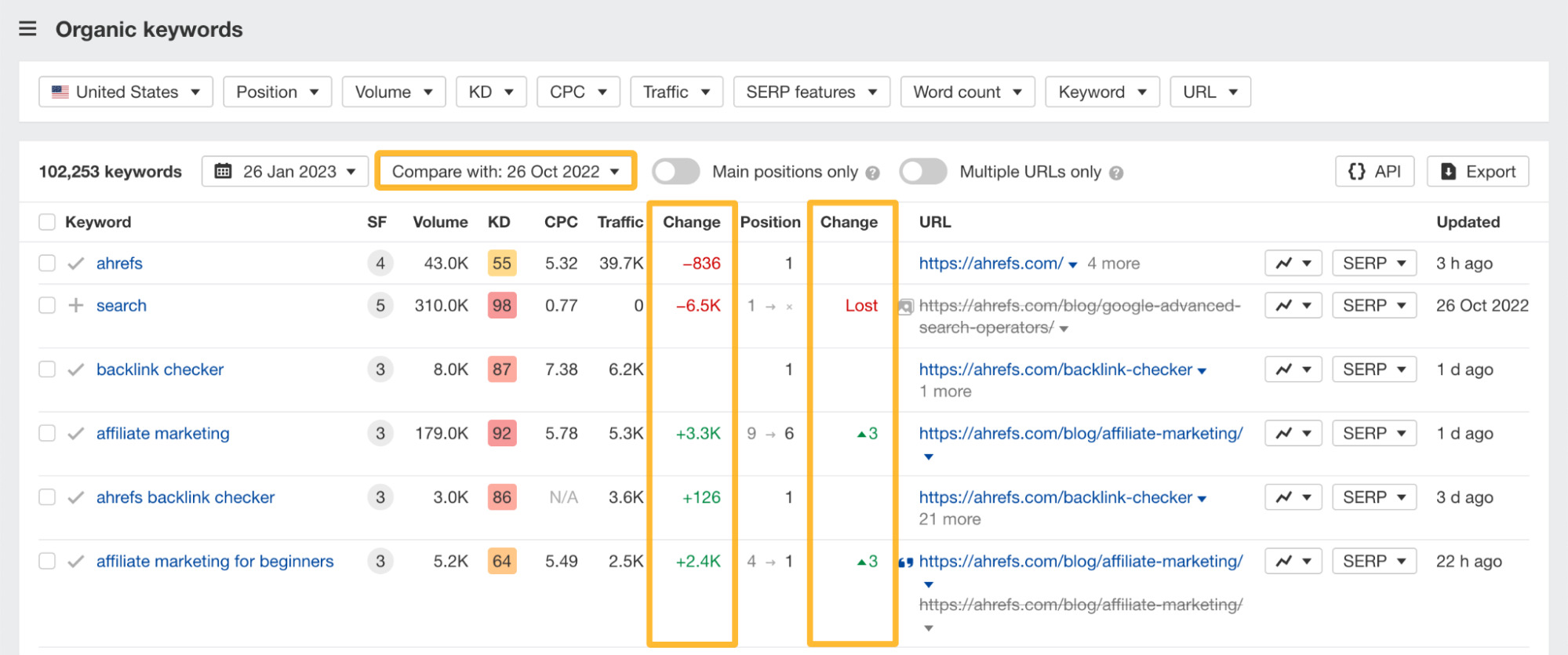
Second, you can open the Top pages report and filter for newly created pages to see how much content your competitors are publishing each month.
For example, our content team has created over 200 pages for our blog in the past three months.
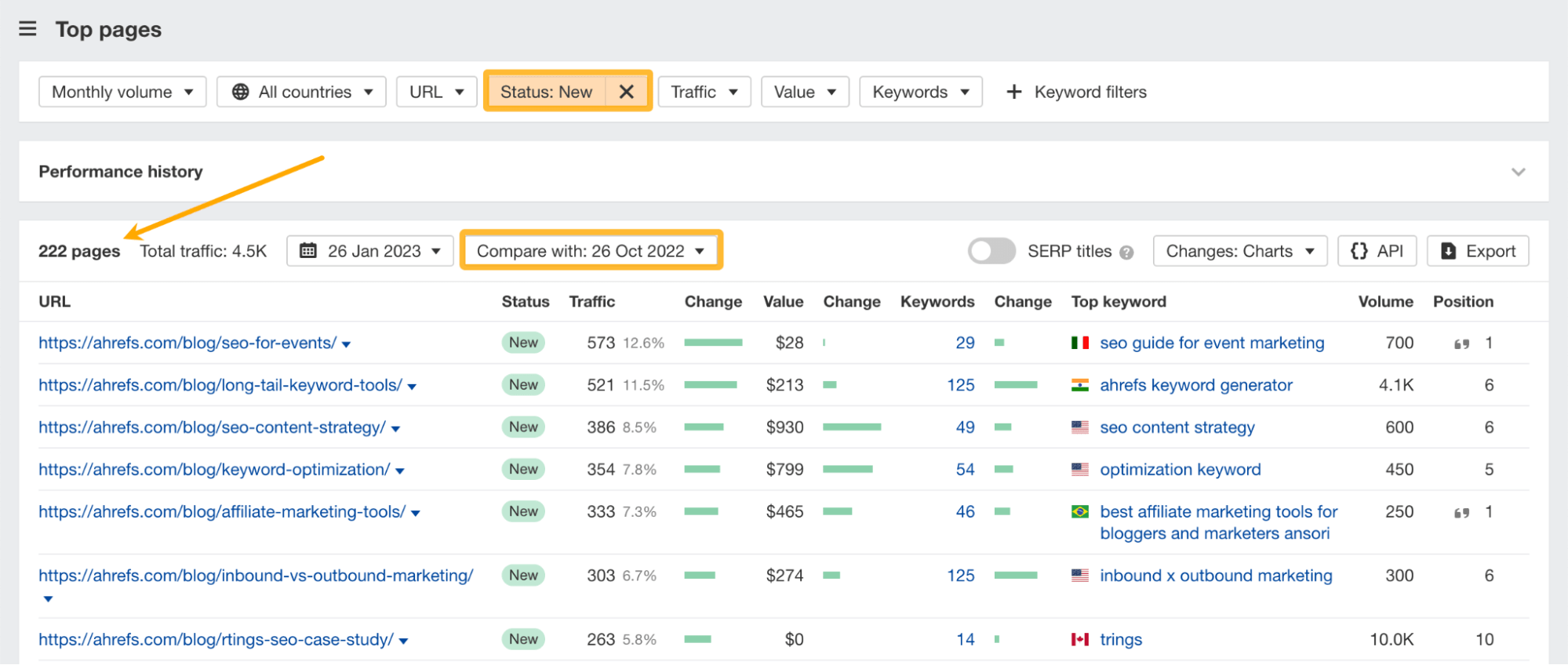
Tip
Use this last use case as an argument for a budget raise.
While the Top pages report is not a feature unique to Ahrefs, what’s unique is that we show top pages for all countries.
Most other SEO tools have either data for only one country or hide the additional data behind a paywall.
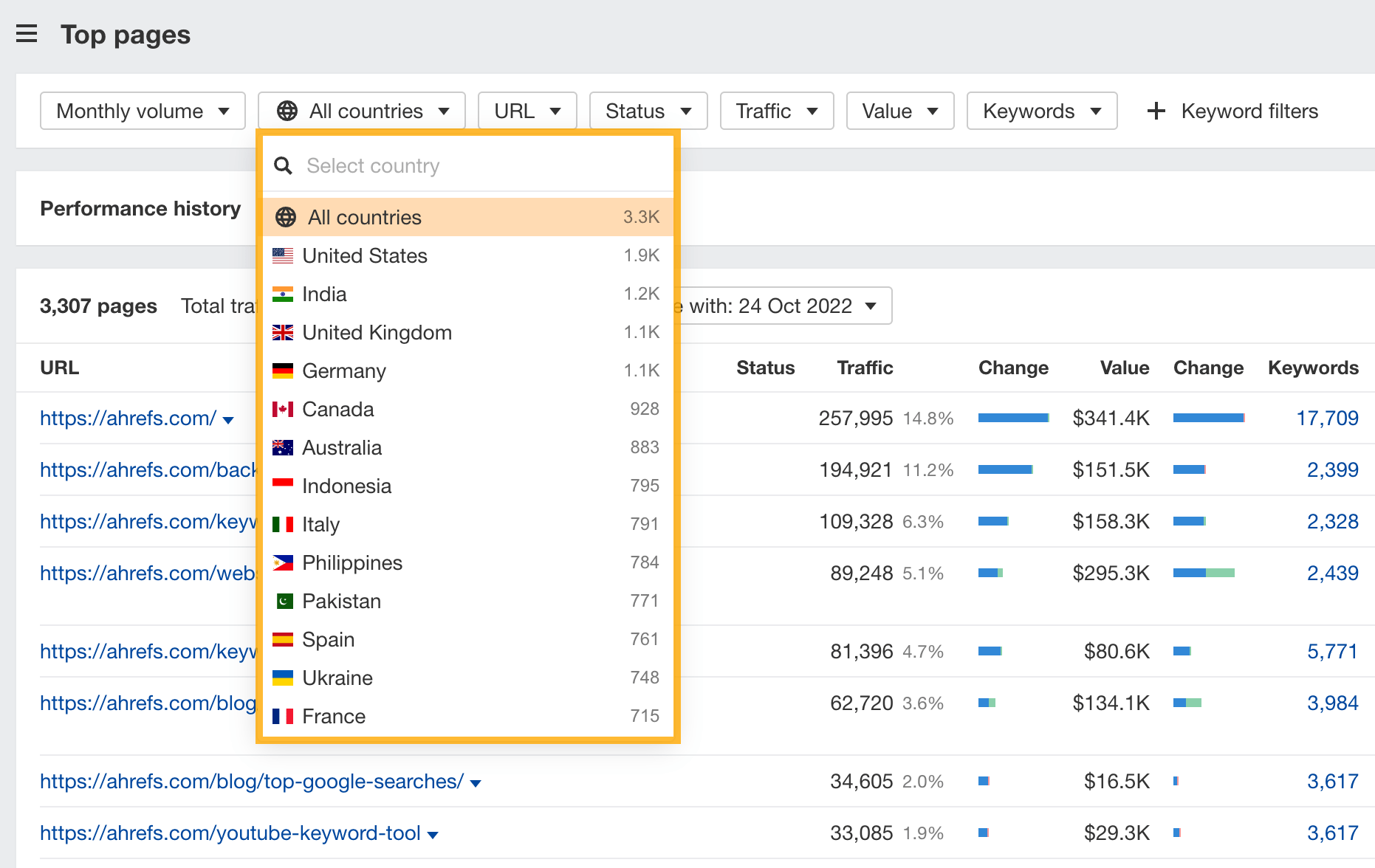
For example, our article about “top google searches” surprisingly ranks #1 in the Netherlands.
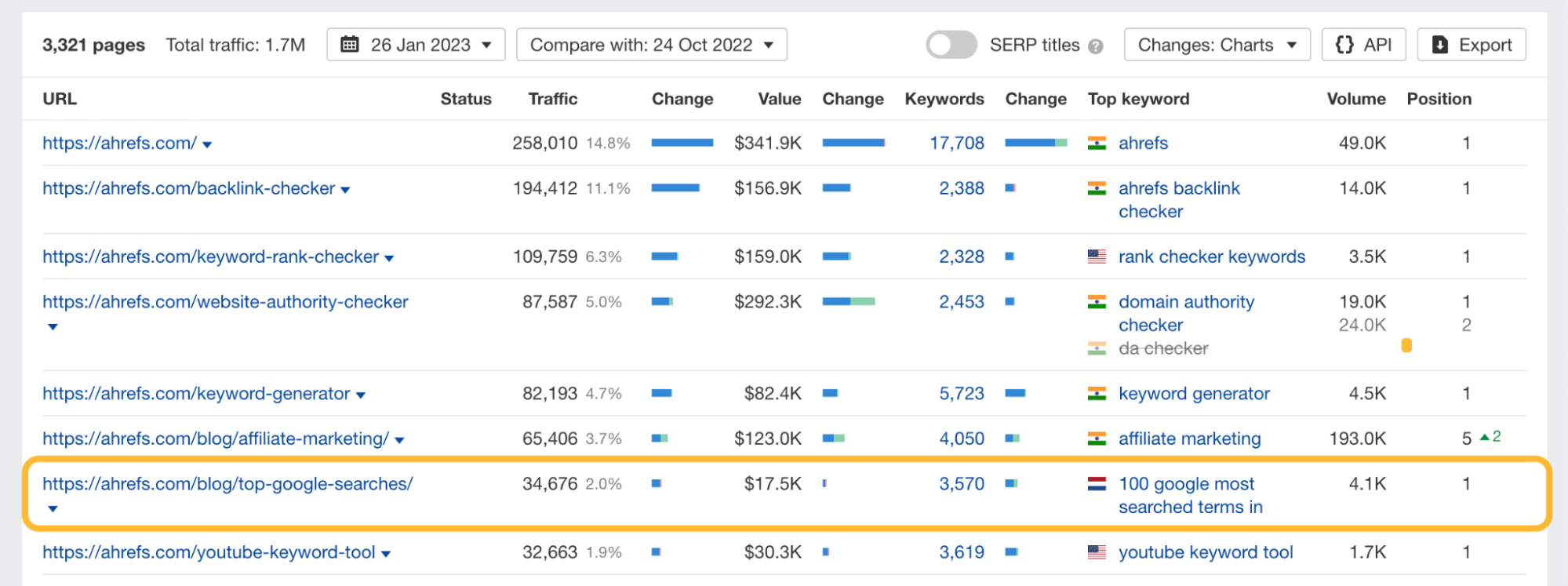
Note
Use this information with caution when replicating your competitor’s success. It might be that most of their traffic comes from the U.K. when you’re looking for visitors in the U.S.
Thanks to our continued investment in web crawling technology and infrastructure, Ahrefs is the only tool to update referring domain graphs daily.
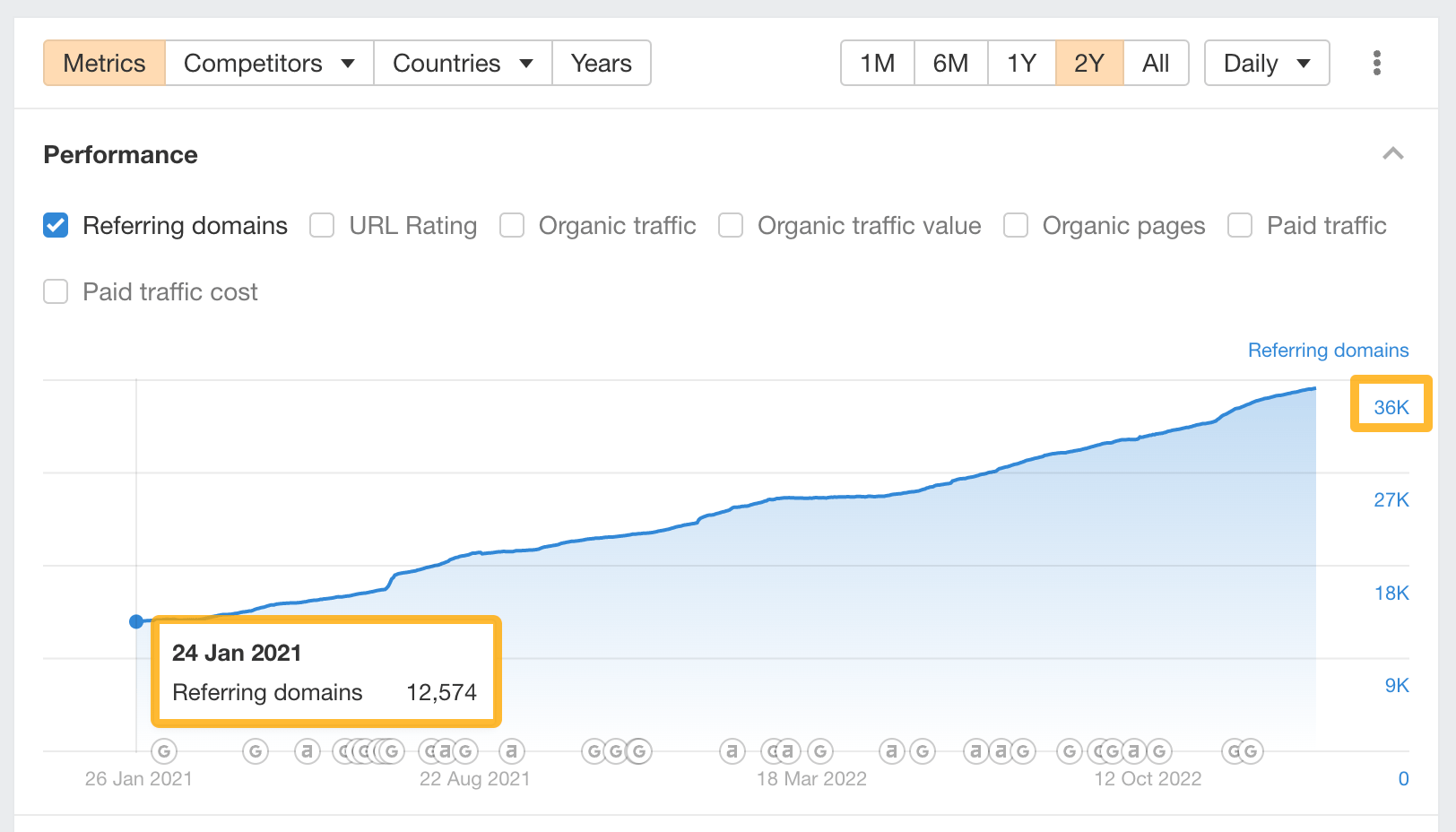
One glance at our blog’s link profile tells us that it gained three times more links from unique referring domains (36,000) than in 2021 (12,574).
This level of granularity allows you to accurately compare your own link acquisition pace with your competitors to see if you’re on track to catch up.
The Site structure report helps you understand a competitor’s website structure in a tree-like format without having to run a crawl.
Use it to analyze their top-level folders and see which ones generate the most organic traffic.
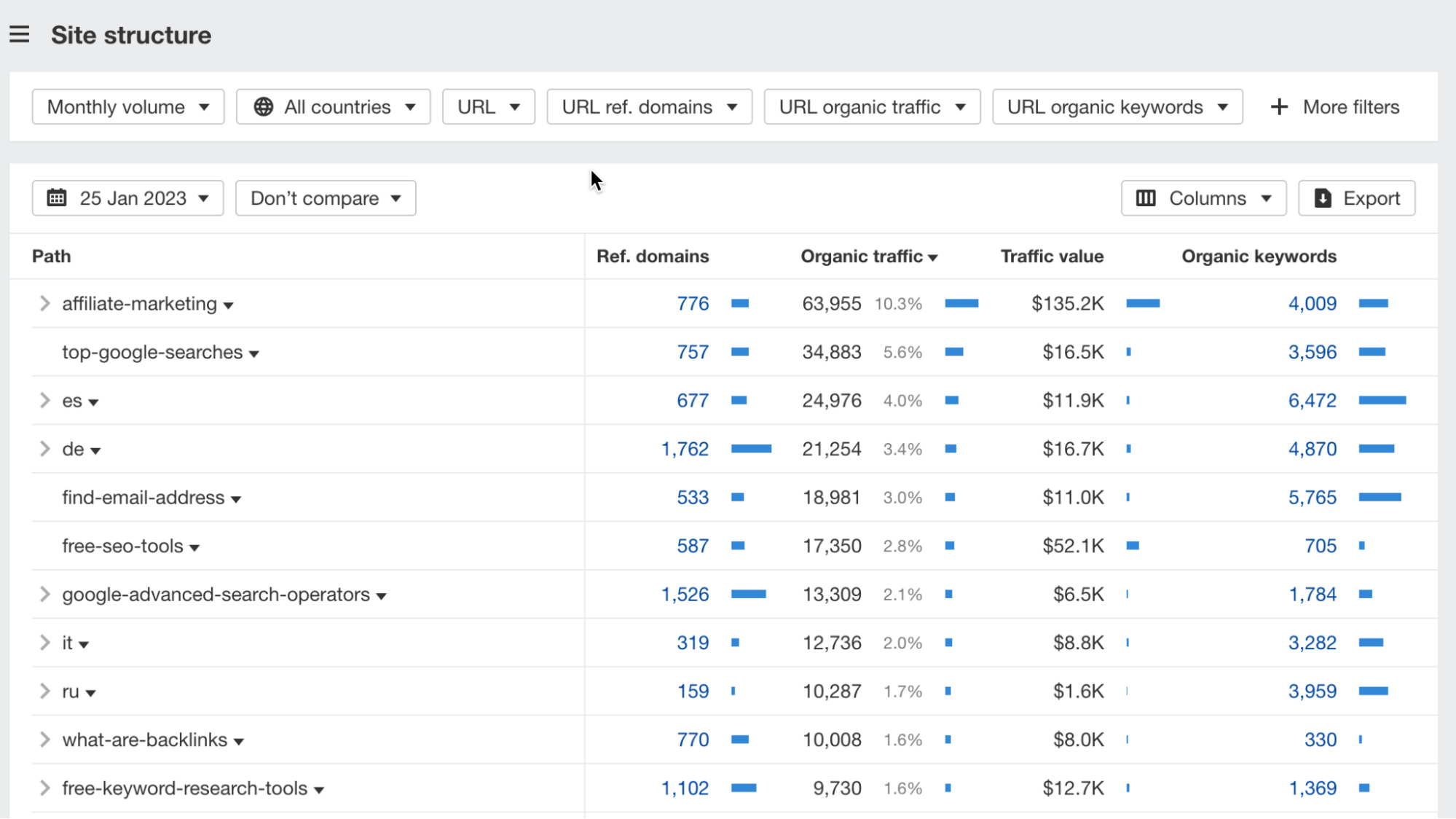
Here are a few key things you can learn about our SEO strategy by skimming this report:
Most SEO professionals look at the search volume of their target keyword to predict a page’s organic traffic potential.
Search volume alone can be misleading, though, as pages rarely rank for one keyword.
A better (and more insightful) way to estimate search traffic is to use Traffic Potential, which shows you how much search traffic you’d get if you were to rank #1 for your keyword.
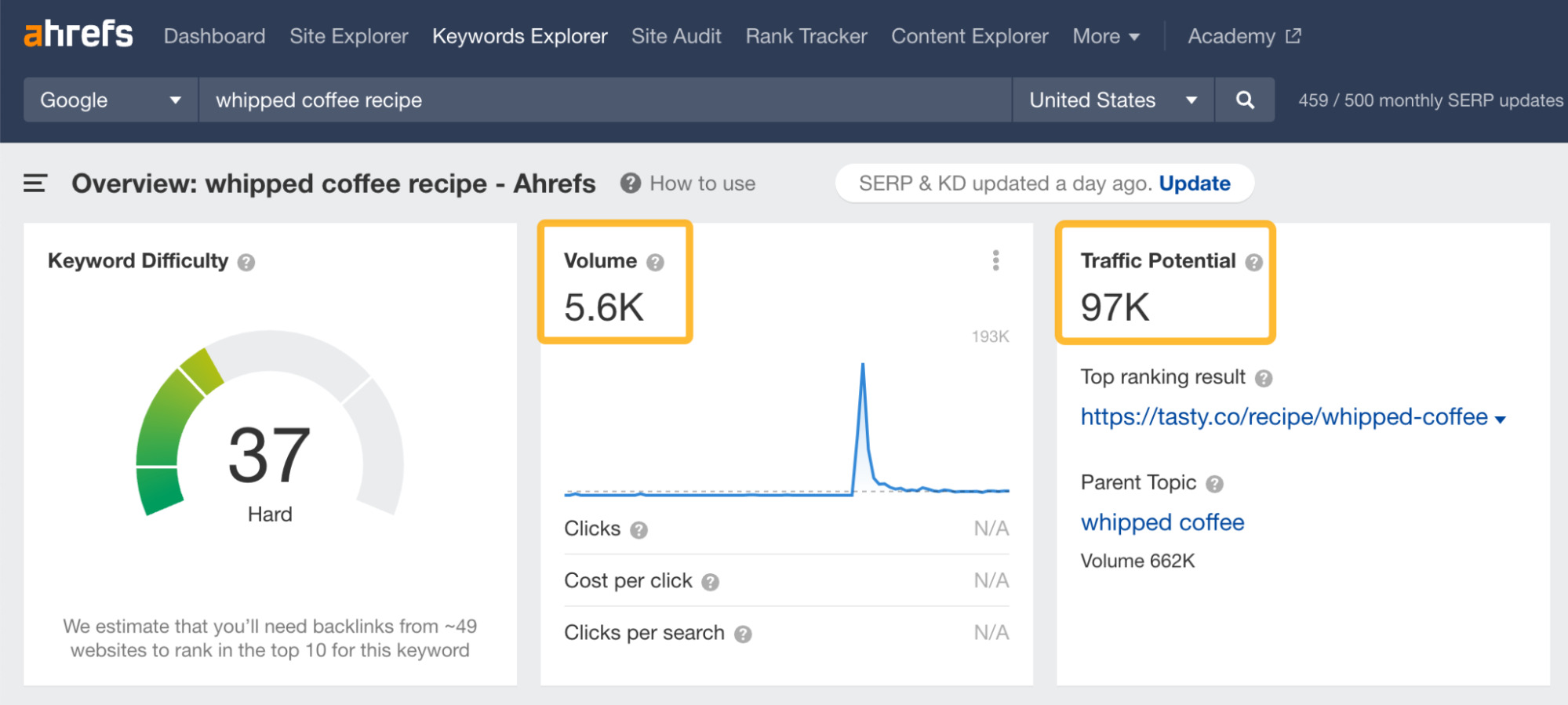
Please note that the traffic is not coming from your target keyword but from all the keywords the top-ranking page is ranking for.

Let’s say you’ve got the following keywords on your list.
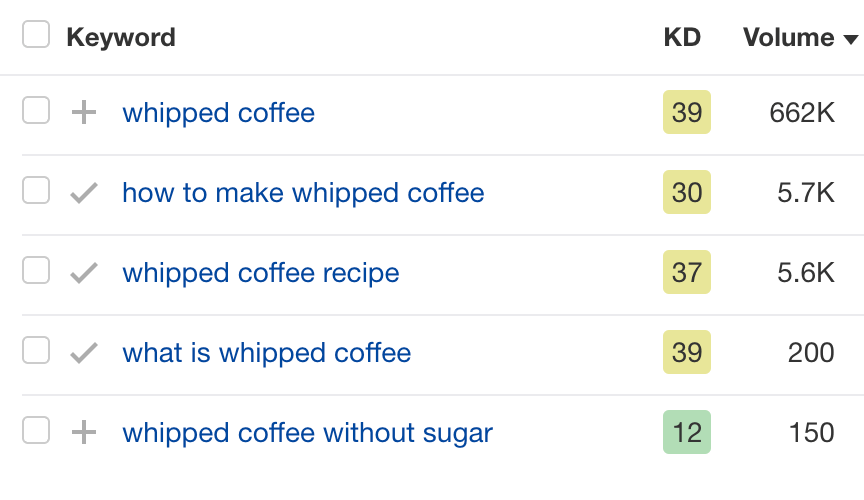
All of them seem to be targeting the same topic. But how do you know whether you should target them with a single page or create separate pages for each of them?
We can find this out by looking at how Google “sees” them. If Google is ranking similar pages for all of these keywords, it means they probably belong under the same topic.
We can see how Google “sees” them by using the SERP comparison feature under the SERP overview.
You’ll be able to compare SERPs side by side for the same keyword on different dates. You could also compare them for different keywords, which is what we’re going to do.
Let’s compare the search results for the keyword “whipped coffee” with “whipped coffee recipe.”
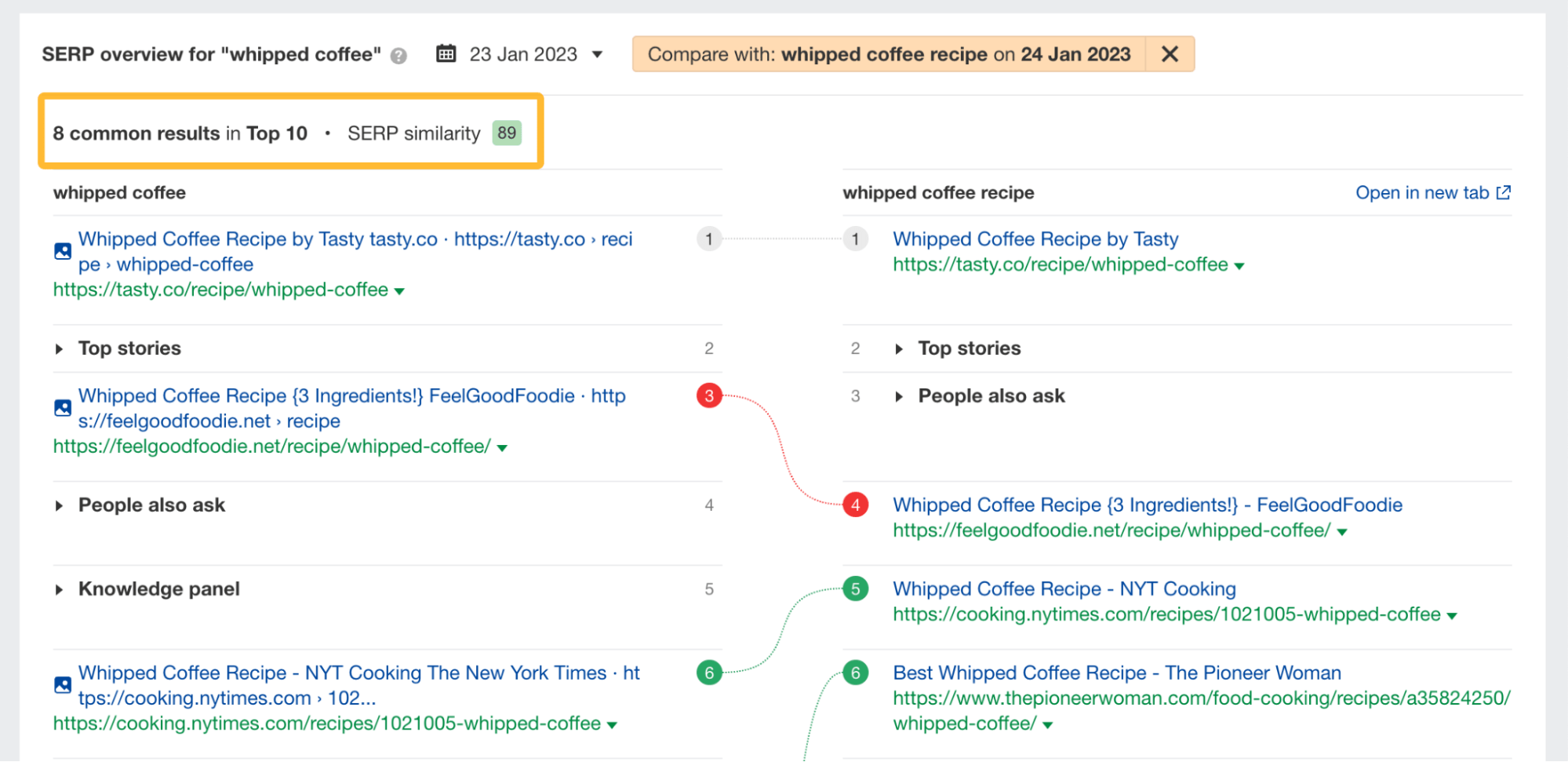
The top-ranking pages for both keywords are nearly identical (8/10 common results), a thing also indicated by our SERP similarity score.
This typically means that Google sees the search query “whipped coffee recipe” as a subtopic of a more general query, “whipped coffee.” Which means you can likely rank for both keywords with a single page.
If we compare “whipped coffee” with “whipped coffee without sugar,” we’ll notice there’s no similarity between the SERPs.
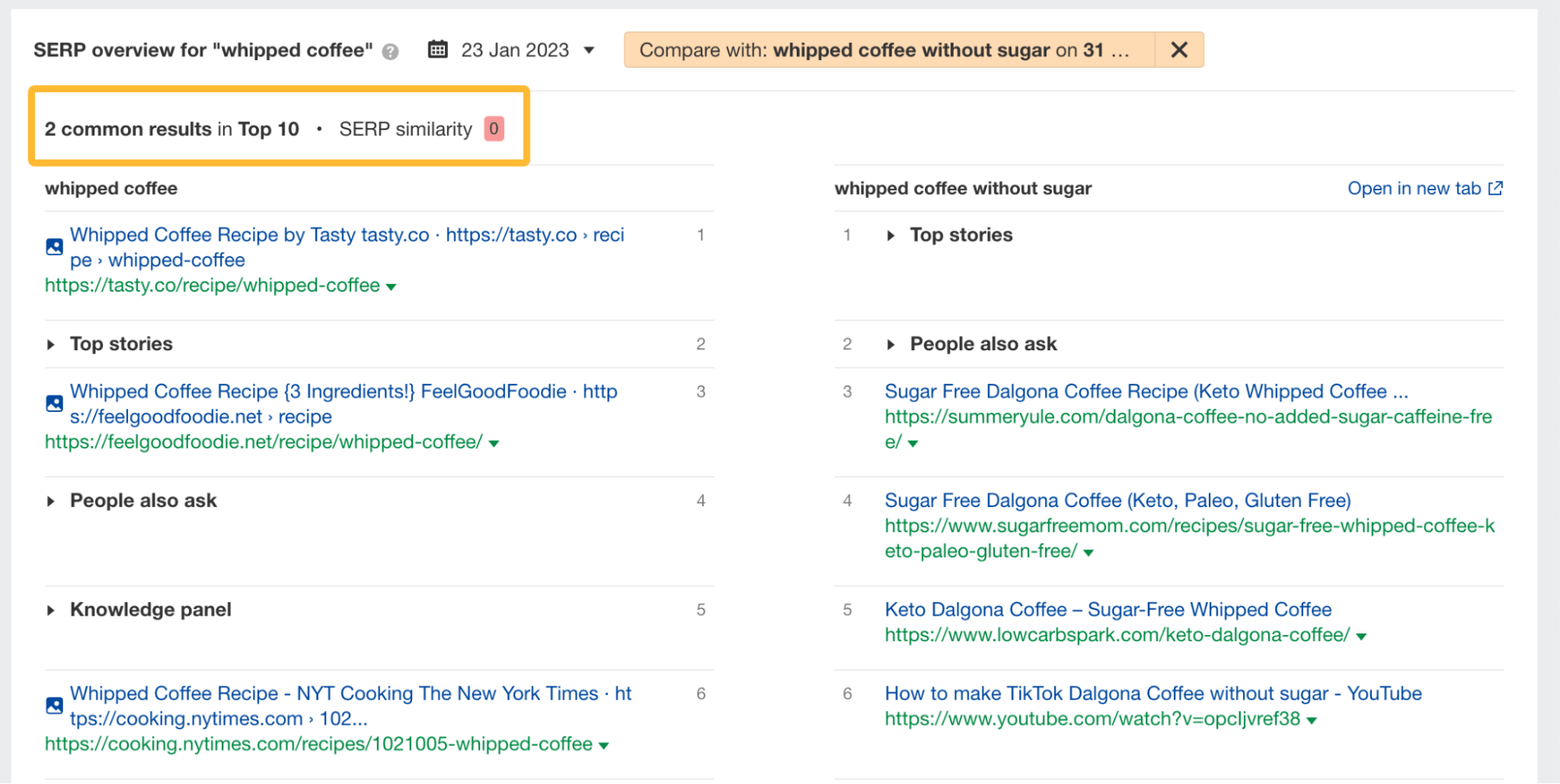
Which means you’ll need to create two separate pages if you want to target both of these keywords.
TIP
This will show you how much their SERPs overlap. Not so much in our latter case, as we’ve concluded before.
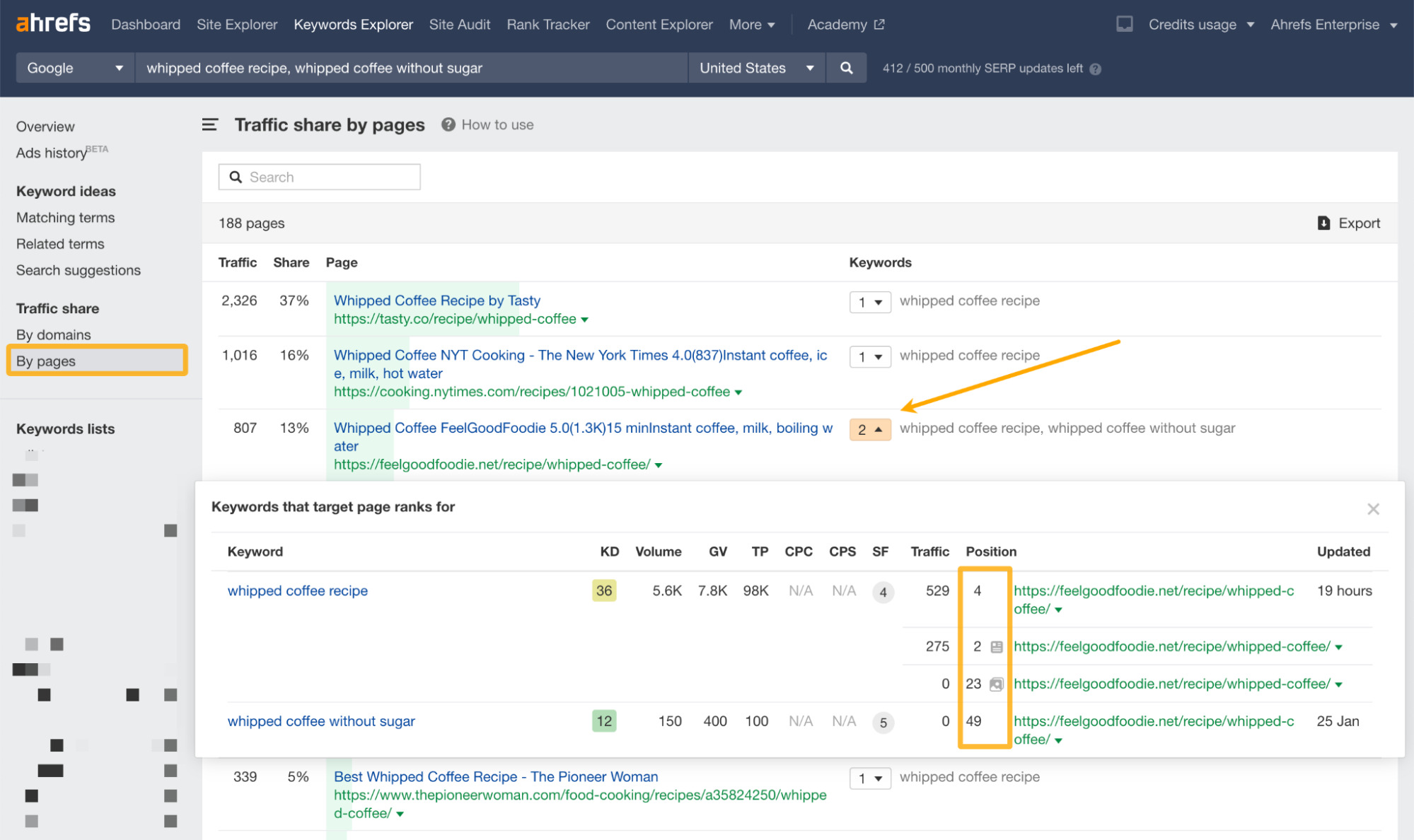
Generating keyword ideas has become fairly easy with Keywords Explorer. Just type in a broad seed keyword, say “espresso,” and open one of our keyword ideas reports.
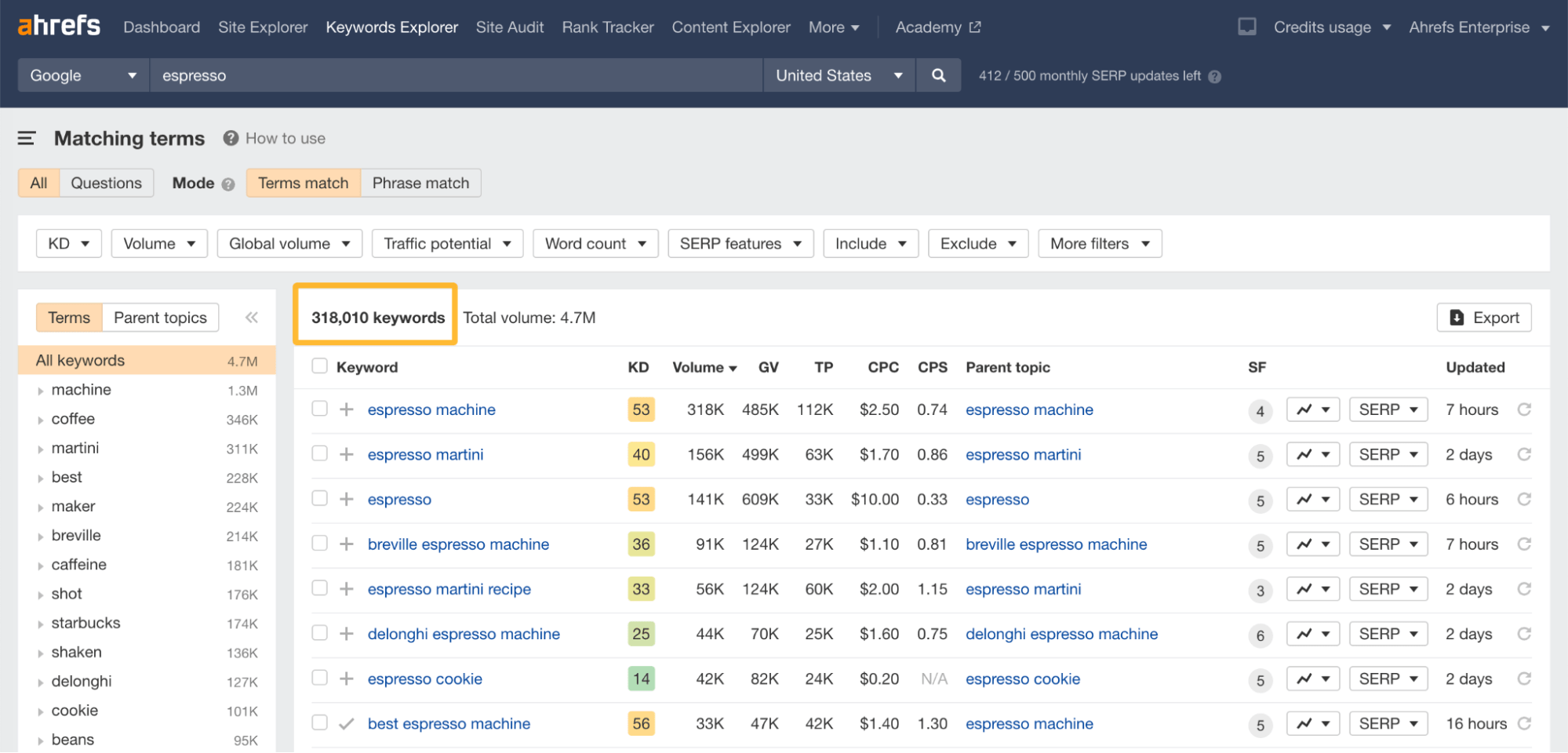
But how do you see the most popular topics under a broad term when there are so many keywords to begin with?
The gist is to group them by Parent Topic. It determines if you can rank for your target keyword while targeting a more general topic instead.
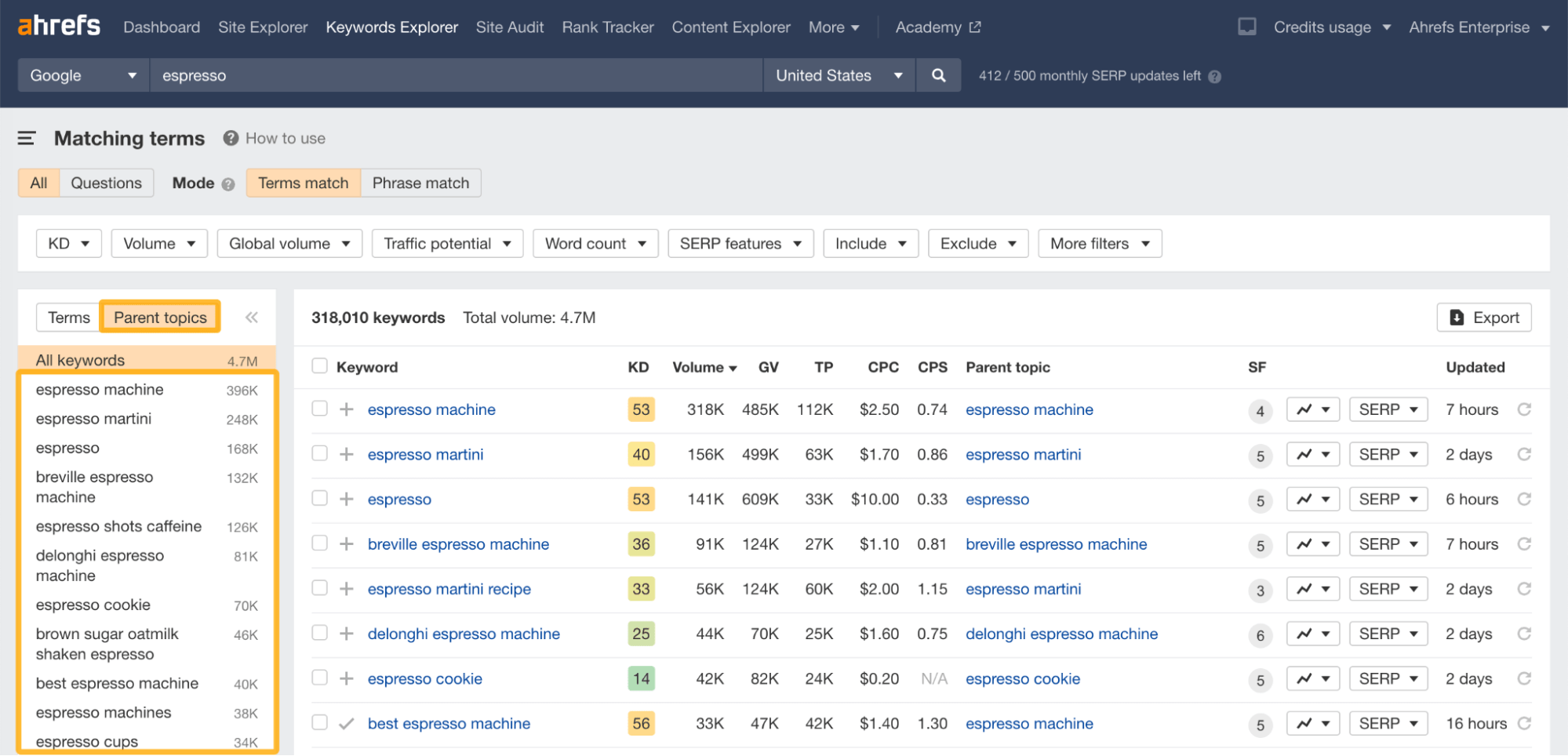
At a quick glance, we can see that people are interested in espresso machines, specific brands like Breville and Delonghi, espresso martinis, and so on.
A topic worth considering is “how to make espresso.” If we click on it, we’ll get a cluster of long-tail queries with the same Parent Topic (“espresso”) that can be covered as subtopics.
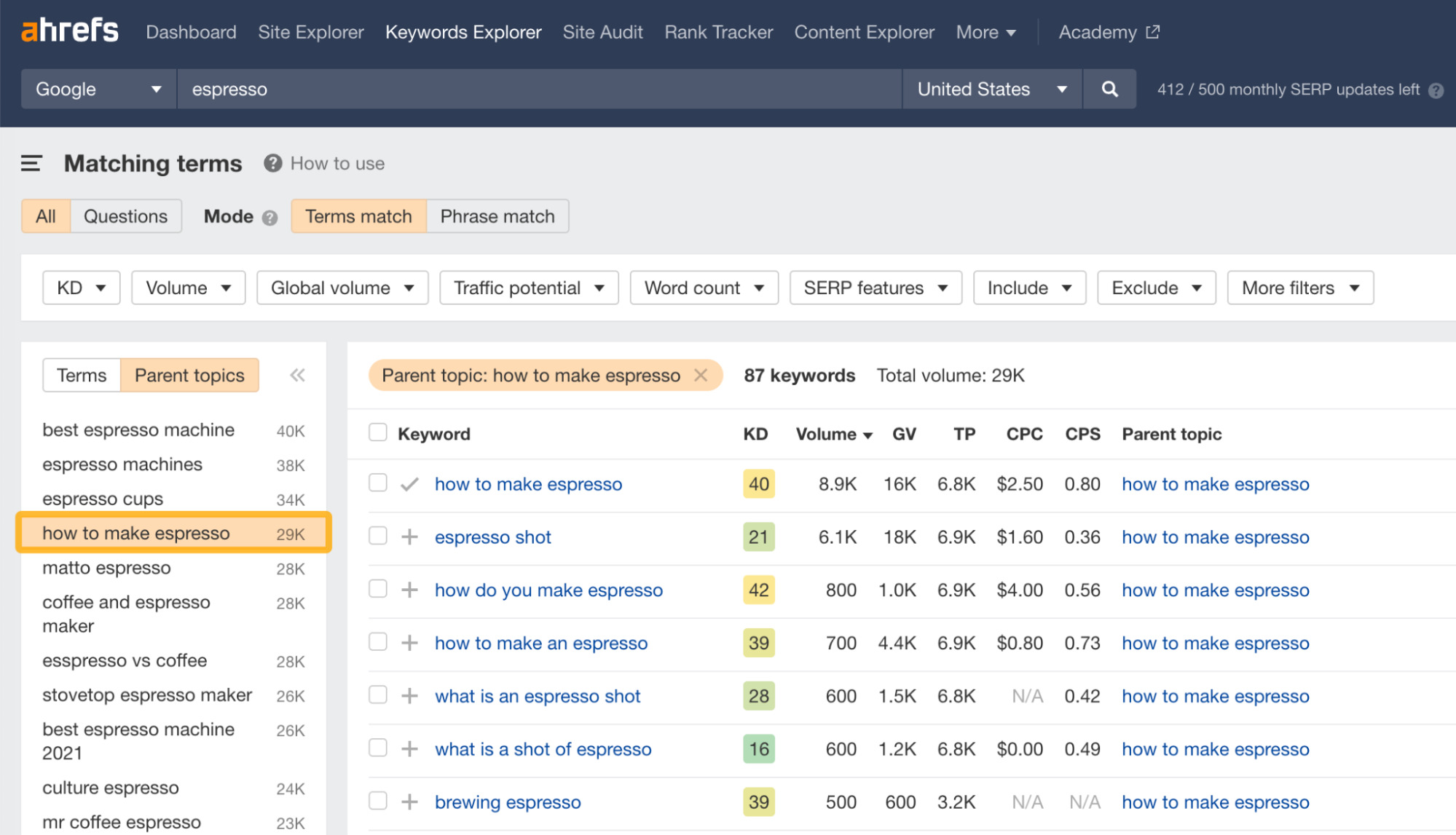
TIP
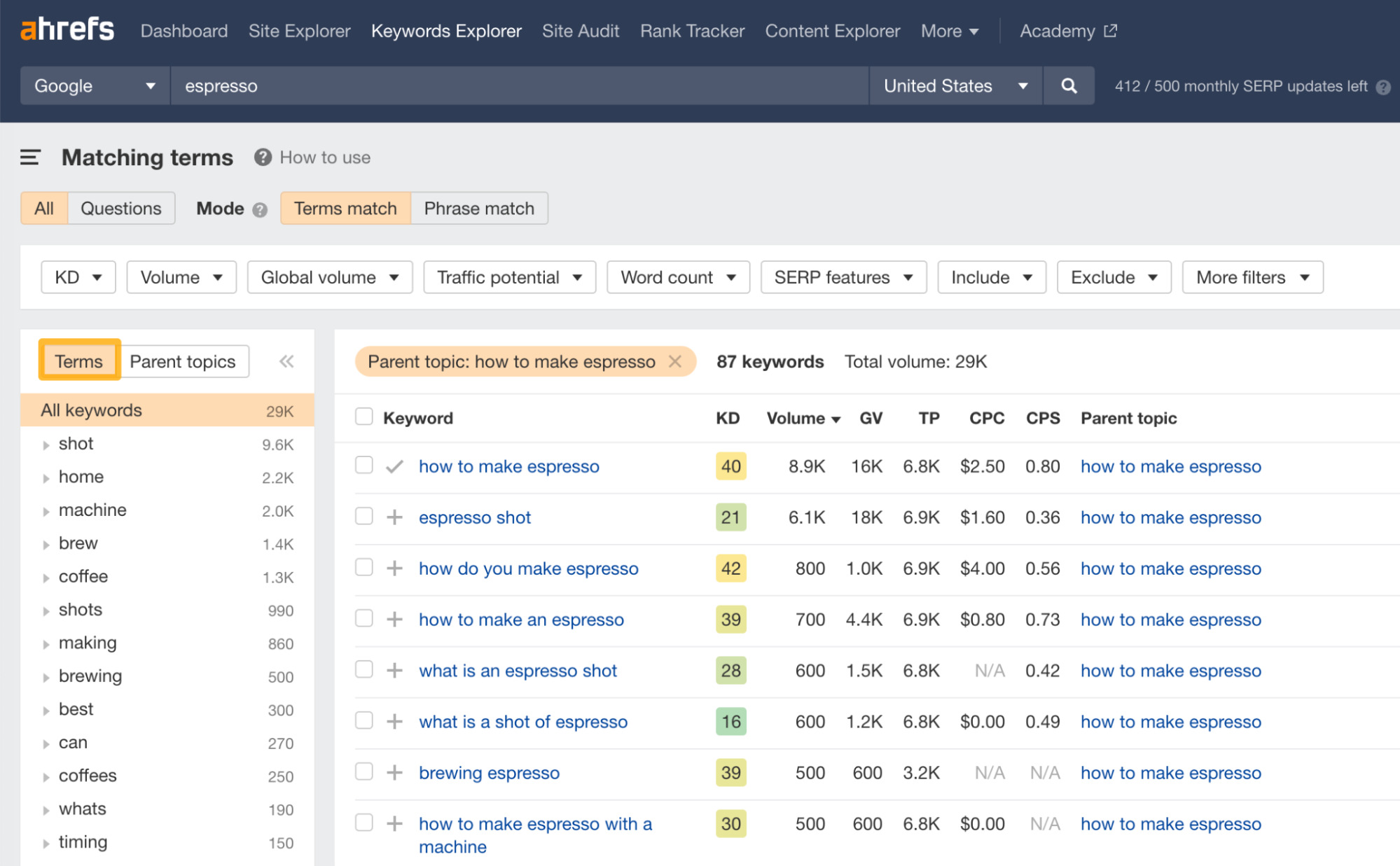
Knowing how your pages used to rank for particular keywords can be extremely insightful. Here’s how you can do this in Ahrefs’ Site Explorer.
- Open Site Explorer
- Enter a website and check the Organic keywords report
- Choose a keyword
- Click the “position history” chart
Here are our rankings for the keyword “website traffic checker” over the past eight years:
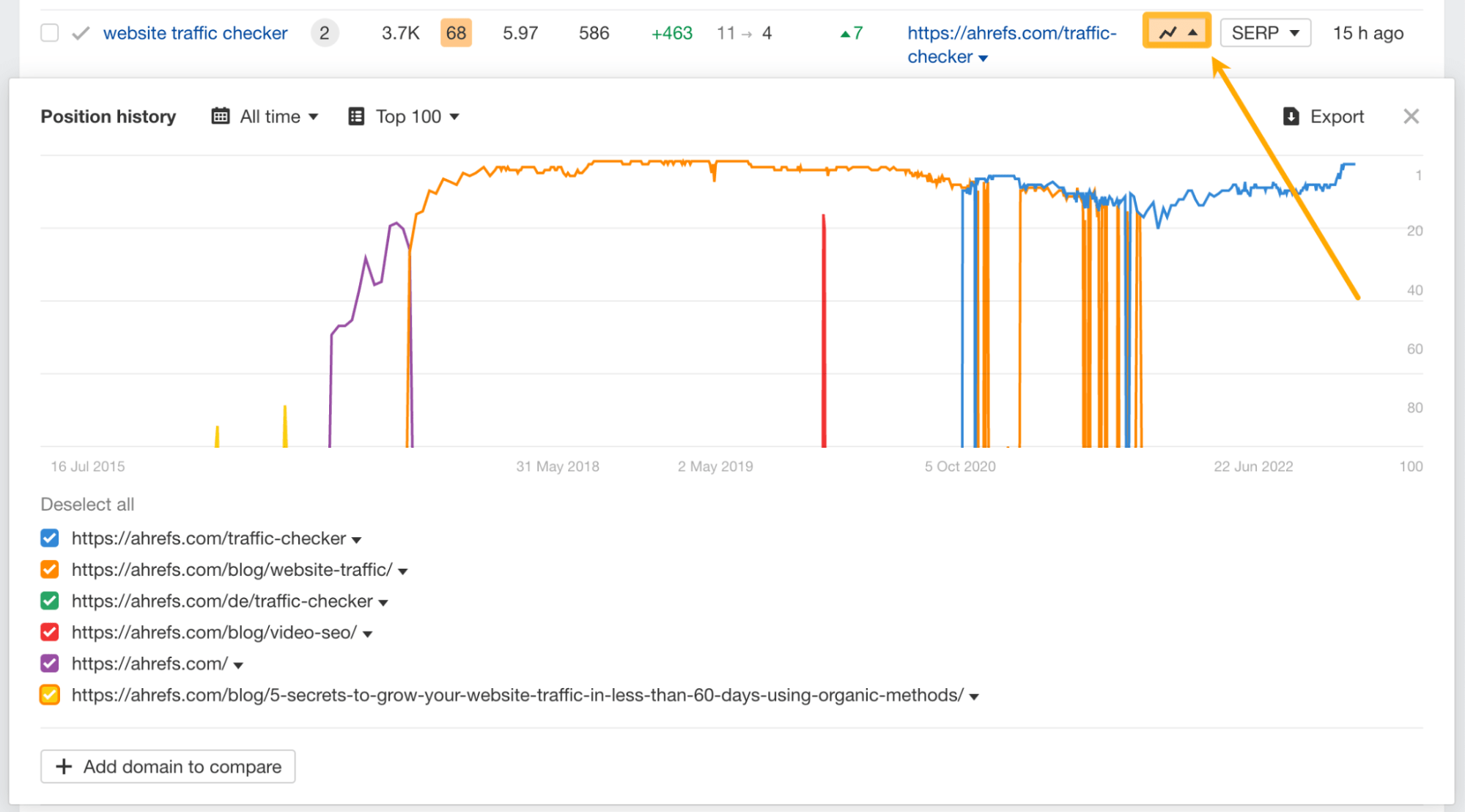
By unchecking a few pages on the list, we can see that our guide on how much traffic your website gets was lagging in rankings on position #21.
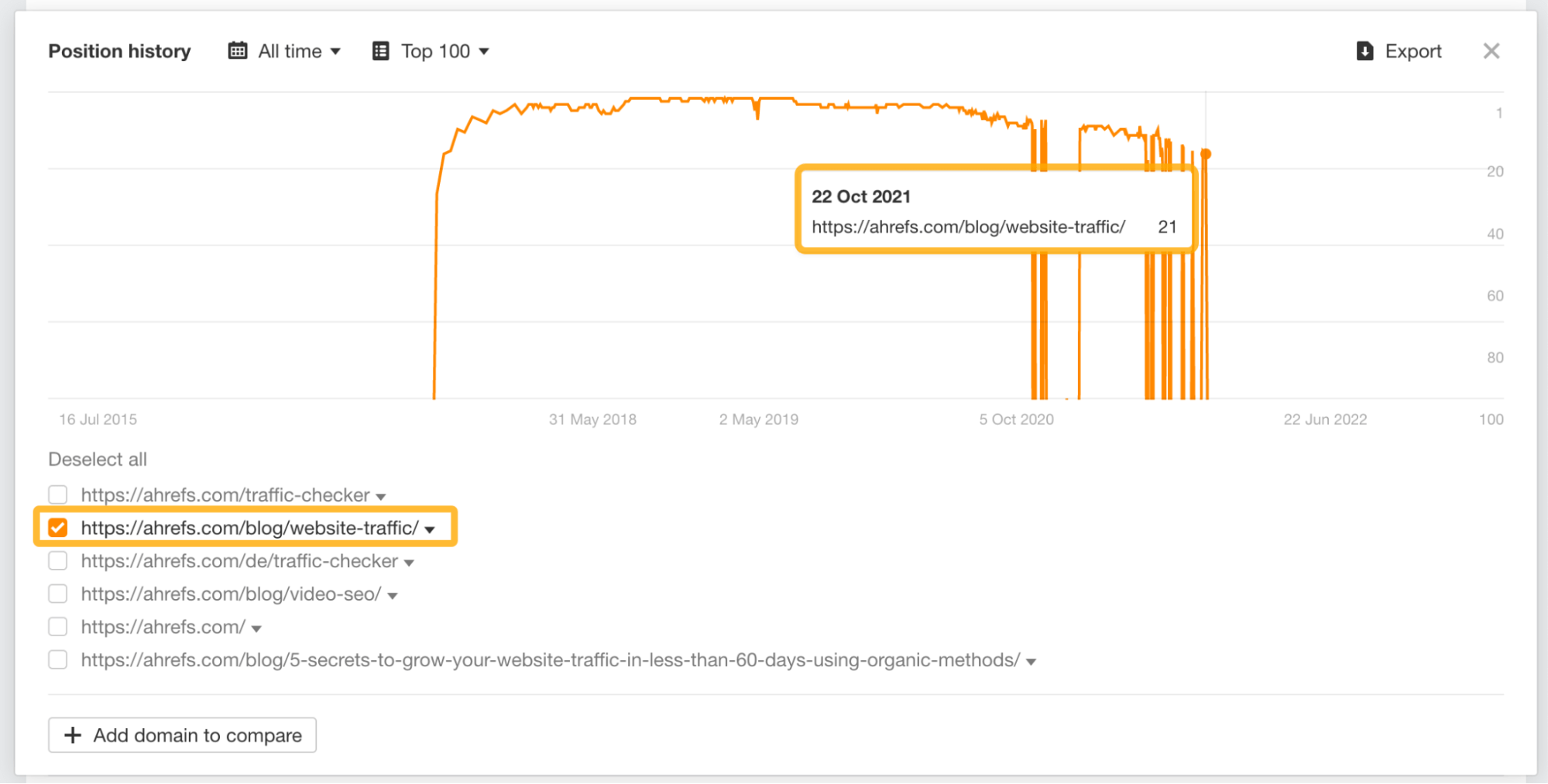
This was up until October 2021, when Google decided to rank another one of our pages for this keyword.
Since then, we’ve launched our free website traffic checker tool. The fact that we’re now in the top five positions shows that the tool matches search intent much better than the initial blog post.
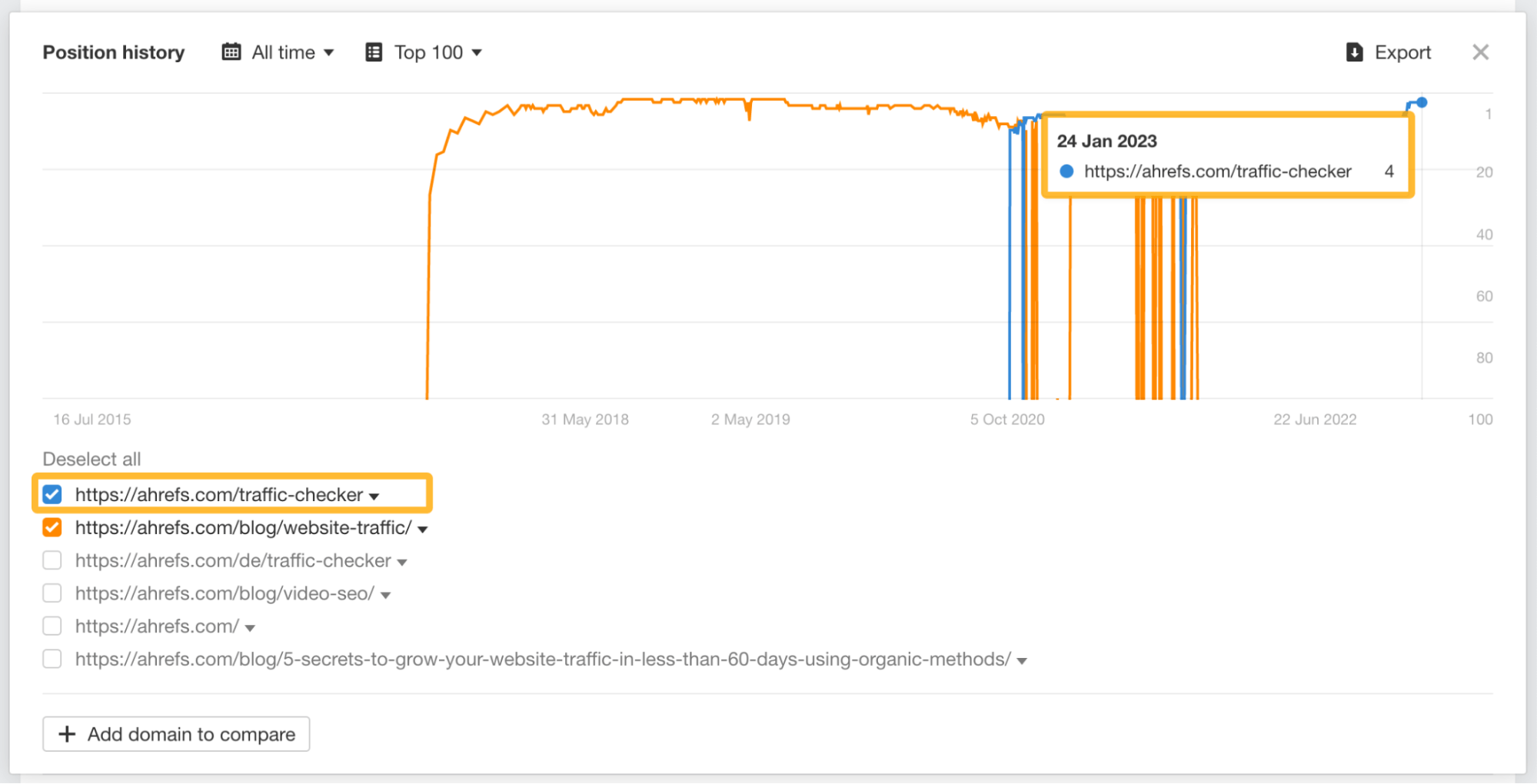
From here, we can add a competitor to compare our performances.
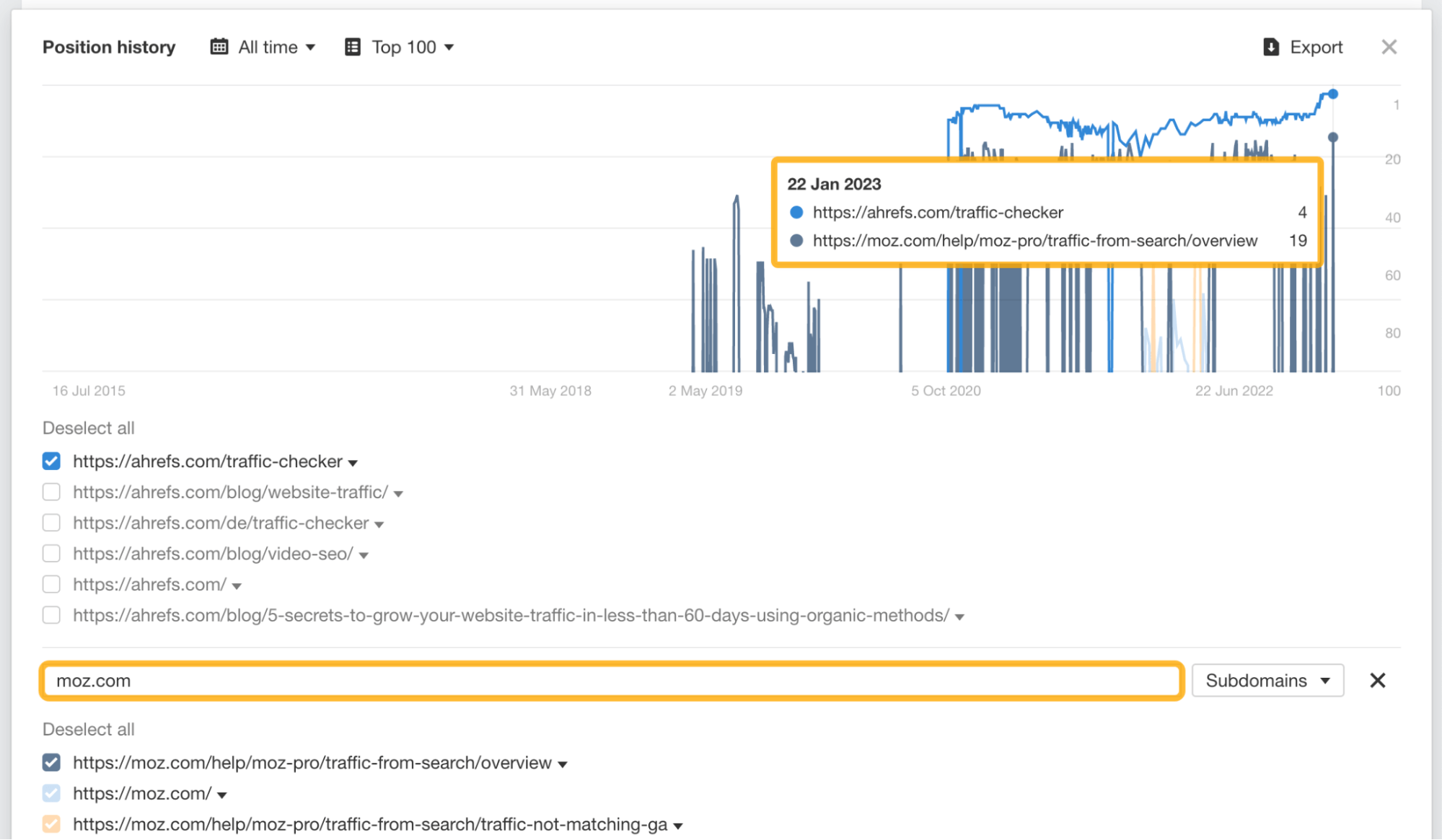
It looks like Moz is not targeting this keyword, which might be better served with a tool rather than a blog post.
TIP: Discover keyword cannibalization issues
Look at Moz’s ranking history for the keyword “local SEO”:
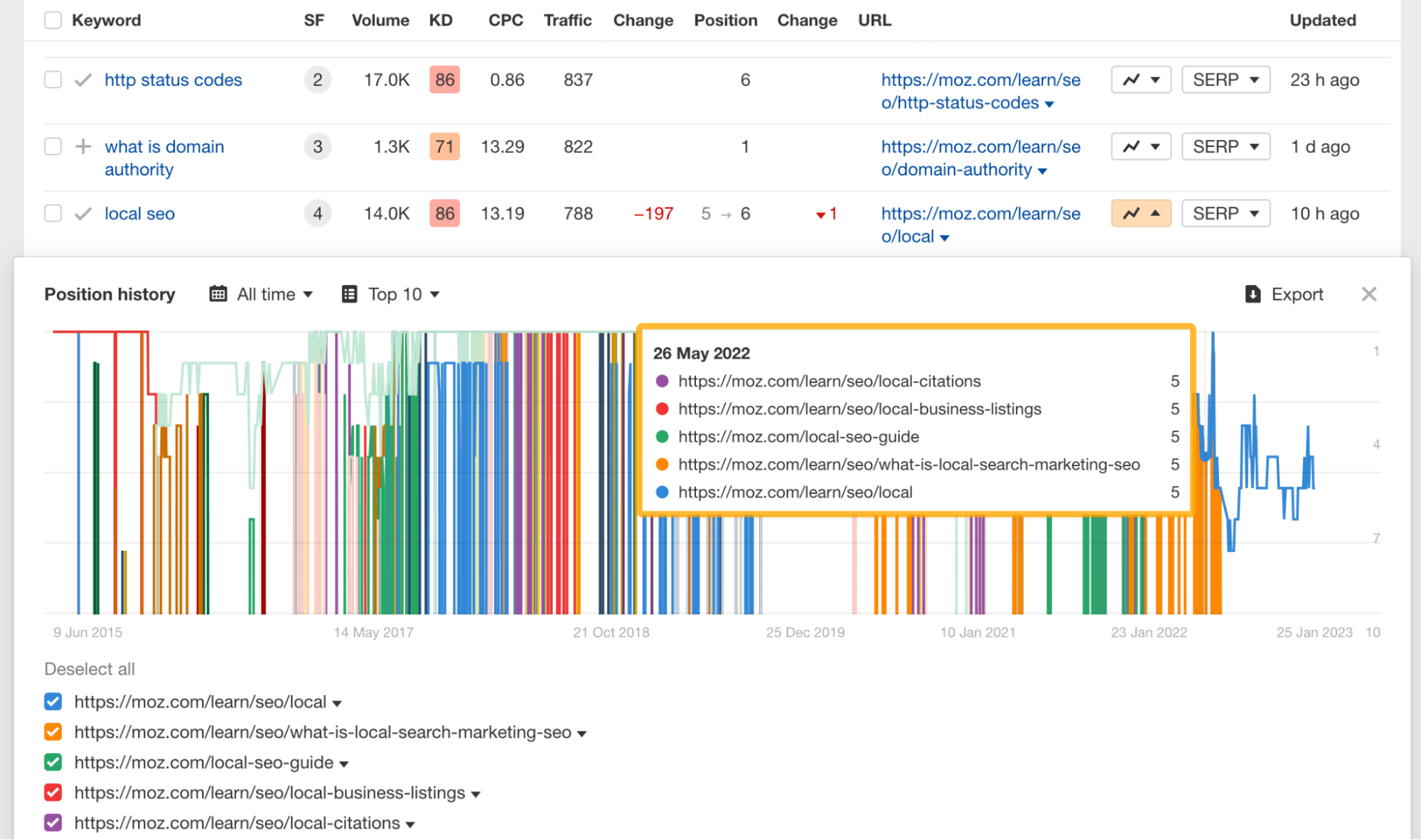
Five unique pages on its site have ranked for this query over the years but not in the top three. This was a potential “keyword cannibalization” issue, which it’s solved by merging them all into a content pillar.
Share of voice (SOV) represents a website’s overall visibility in the organic search results for a set of tracked keywords.
At the same time, it’s one of the few vital metrics for measuring SEO ROI.
To see your website’s share of voice for a given set of keywords, first paste them in Keywords Explorer and select the Traffic share by domains/Traffic share by pages reports.
The fun part: You will most likely discover organic competitors that you weren’t even tracking who are sneaking up the same SERPs you’re trying to win.
For example, we write mostly about SEO and marketing. But we never thought Shopify would target similar topics, since our businesses are completely different.
It earns about 9% of the organic traffic for the keywords we pasted. Hence, we can research its top content and reverse engineer any low-hanging SEO wins it has.
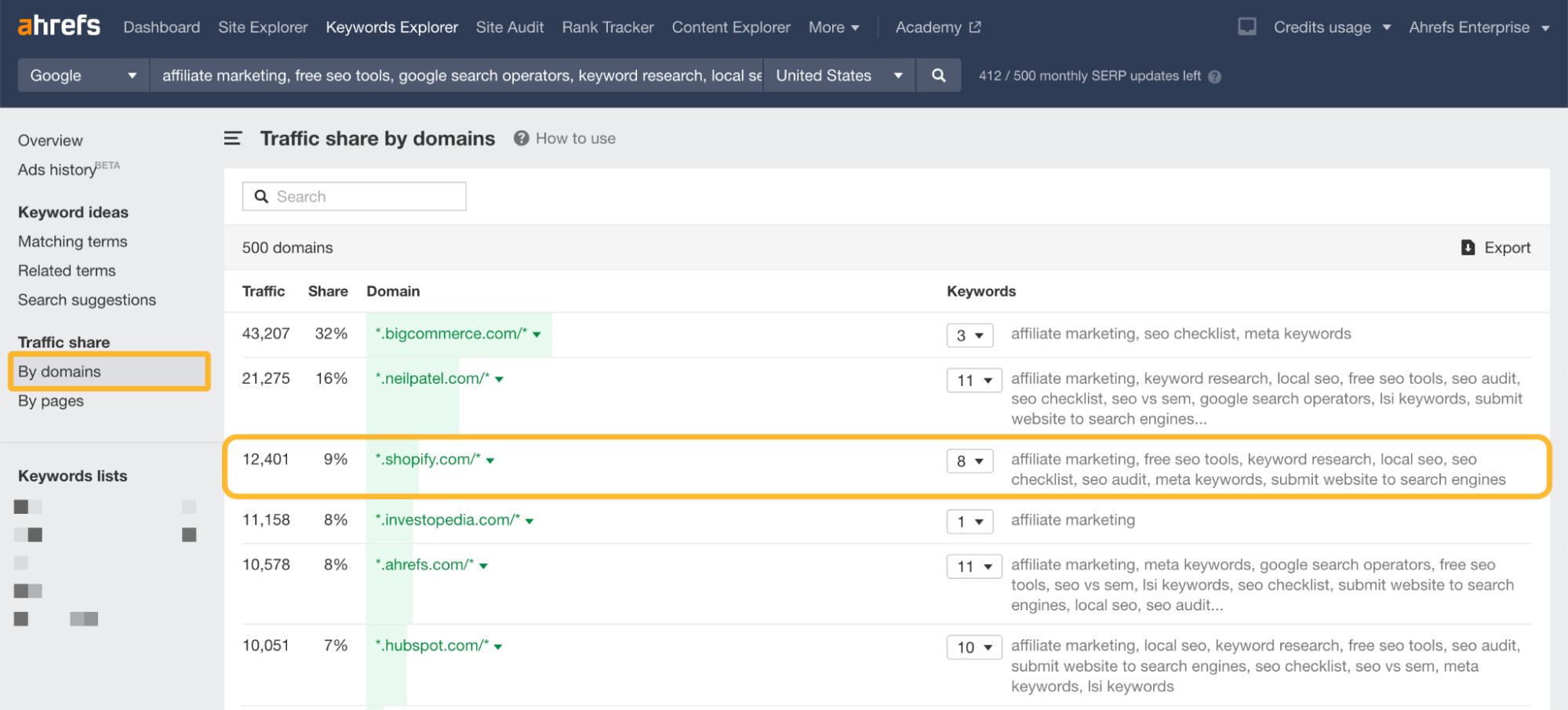
SEO crawls are crucial for monitoring your website’s SEO health over time. Yet not every website is built the same, which may require a bit of tweaking to the actual crawl settings.
Ahrefs’ Site Audit has got your back, featuring editable and customizable SEO issues.
At a global level, you can change the importance of an SEO issue and decide whether to apply it to existing projects or not.
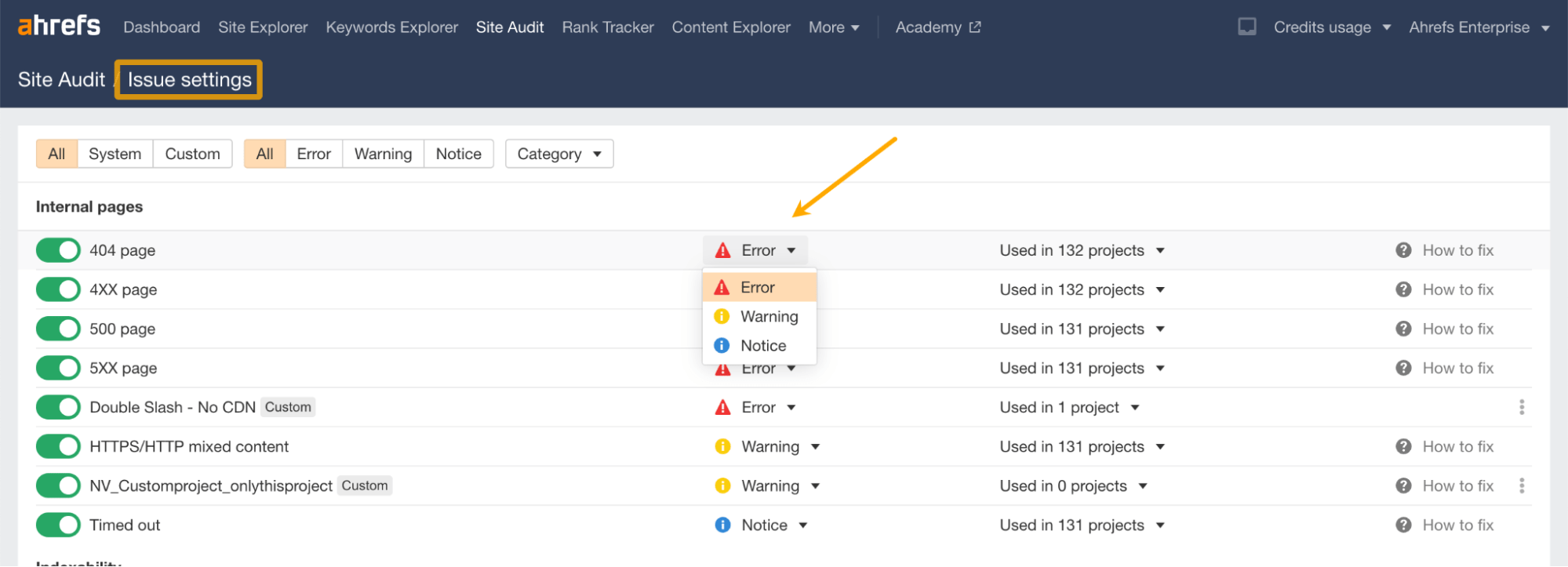
While at a project level, you can turn off certain SEO issues.
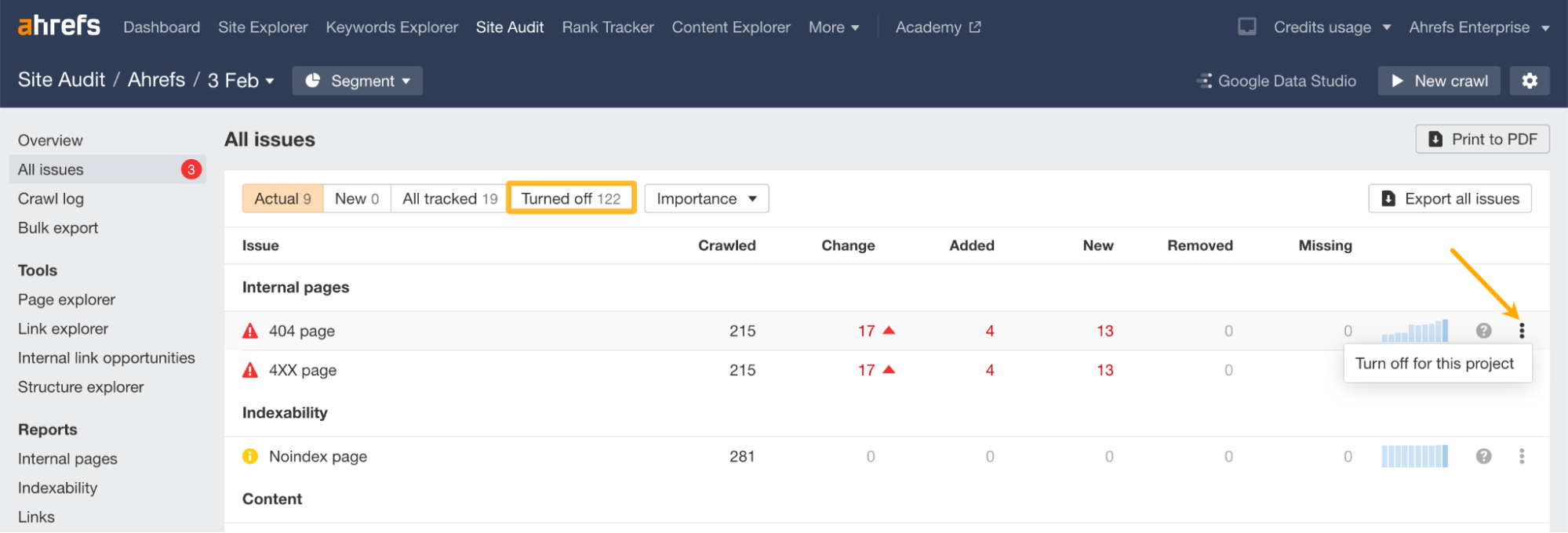
Both settings are of great importance when calculating a website’s Health Score, as we only take into account links with errors (links with warnings and notices are not factored in). Thus, the higher the number of errors that show up, the lower the Health Score.
Similarly, you can customize your own issues, which will take the specific attributes within the Page explorer report. Like a custom error where meta descriptions are longer than 160 characters.

Speaking of customization, Site Audit also allows you to configure a segment, save it, and return to it in just a few clicks.
This comes in handy because most website owners and SEOs want to isolate issues related to a specific section of a website, such as /blog, /store/, or perhaps a subdomain like es.ahrefs.com.
To set one up, click on Configure > Configure segment.
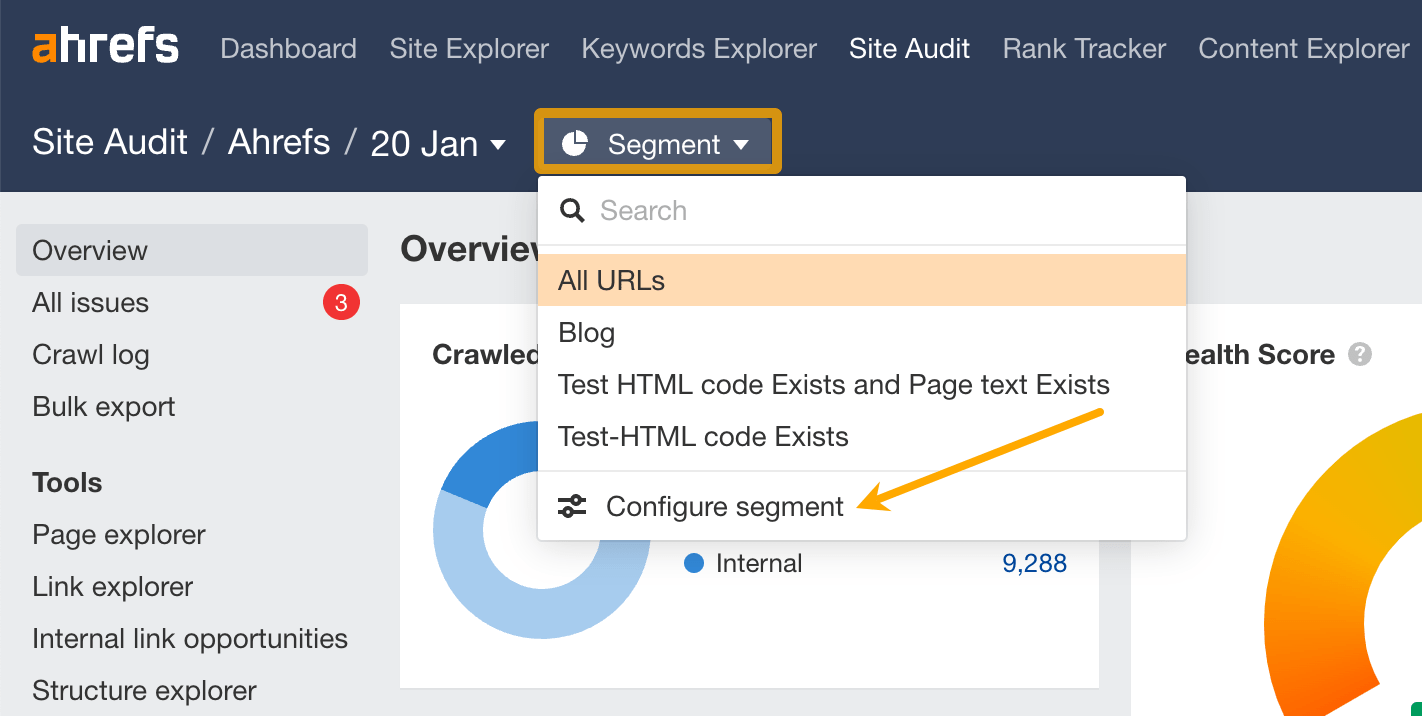
Note
The segment will be applied to every report in Site Audit.
Internal links are crucial to SEO. They help Google discover new content on your website and pass link equity from high-authority pages to low-authority ones.
But let’s face it: Building internal links is time consuming.
Not if you’re using Ahrefs’ Site Audit.
Our Internal link opportunities report identifies internal link opportunities by taking the top 10 keywords for your ranking pages—then finding mentions of them on your other pages.
Including important keyword metrics and the keyword context. How cool is that?

TIP: Find internal link opportunities manually
Despite this, you can still find the pages mentioning your terms by going to the Page explorer report and searching for the keyword within the HTML feature.
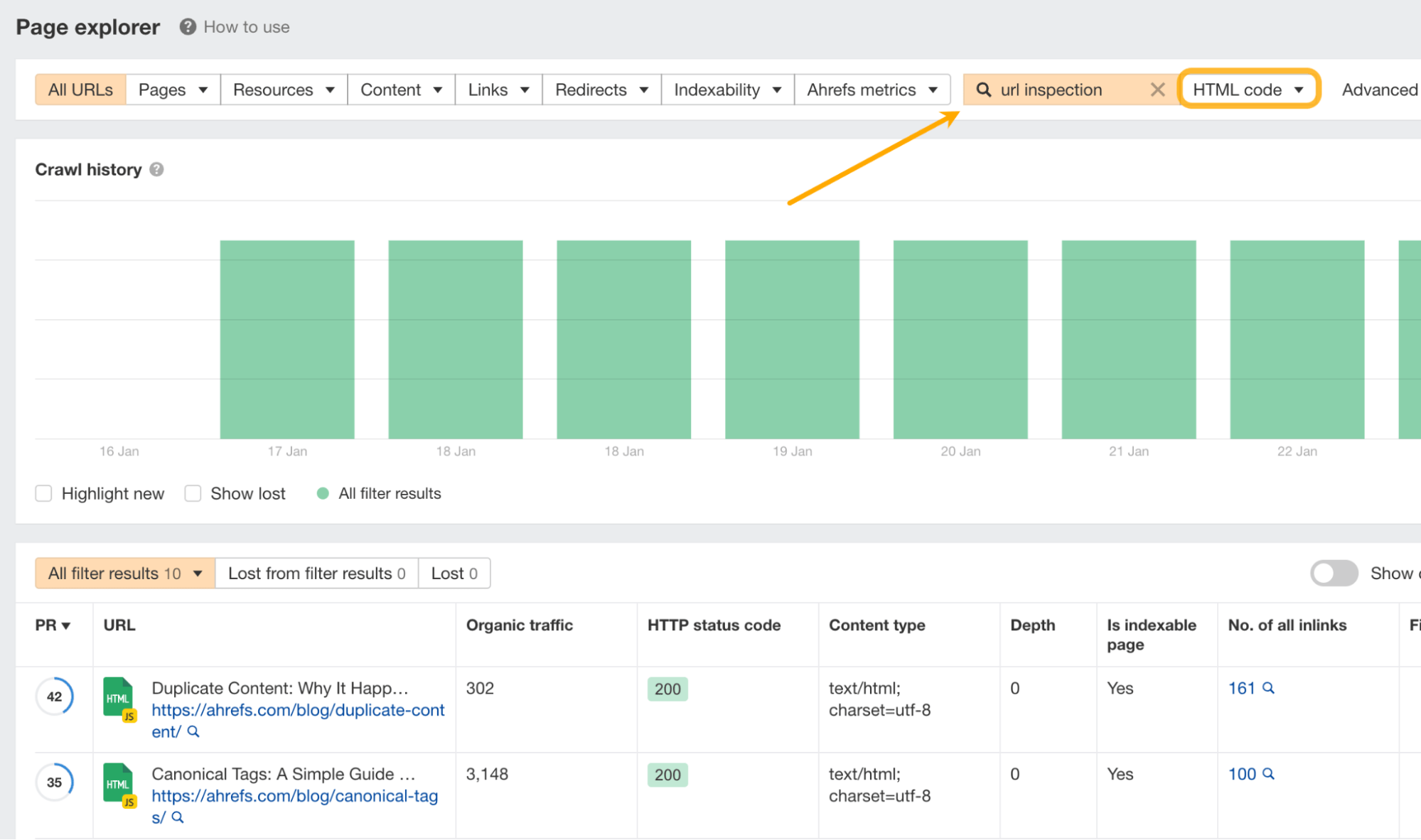
Ahrefs’ Content Explorer is a searchable database of 12 billion webpages, complete with these proprietary metrics:
- Domain Rating (of the parent website)
- Number of referring domains
- Organic search traffic
- Word count
- Publish date
- Updated date
- Live/broken
- Author
No close competitors for the tool exist, and there are more use cases than I have time to cover in this article. So let me share two of my favorite ways to use it.
A. Find low-competition topics with high traffic potential
Want to get content ideas that are easy to rank for?
Search for a broad topic like “backpacking” in Content Explorer and apply these two filters:
- Referring domains < 5
- Page traffic > 1,000
In return, you’ll get a list of relevant pages that get lots of organic traffic and are easy to rank for.
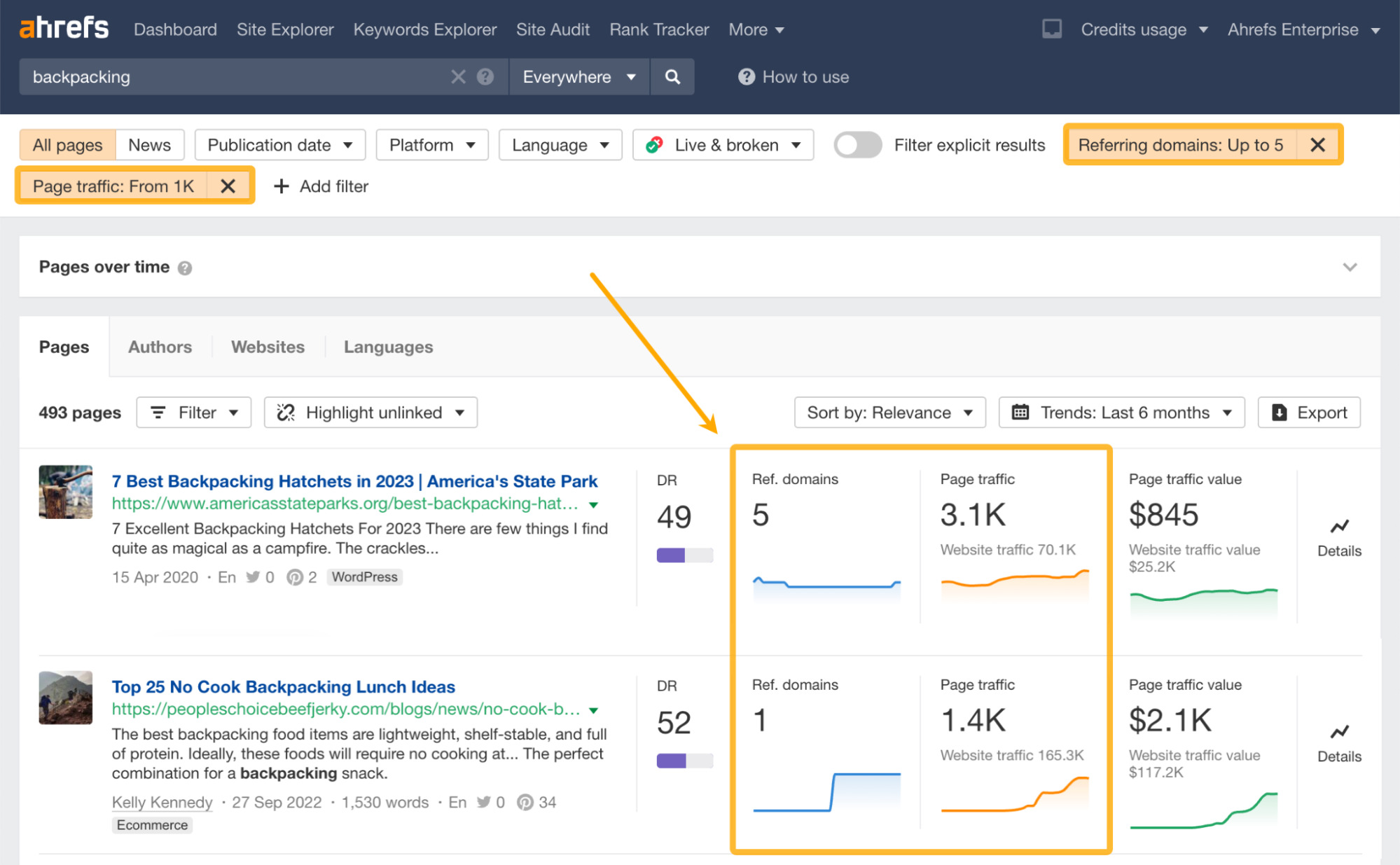
From here, you can dig further into the keywords responsible for the organic traffic.

B. Finding broken link building opportunities
Search for pages with a relevant word or phrase in their title, filter for Only broken pages, then filter for results with at least 50–100 referring domains.
Here’s a dead recipe nutrition calculator with 490 referring domains.
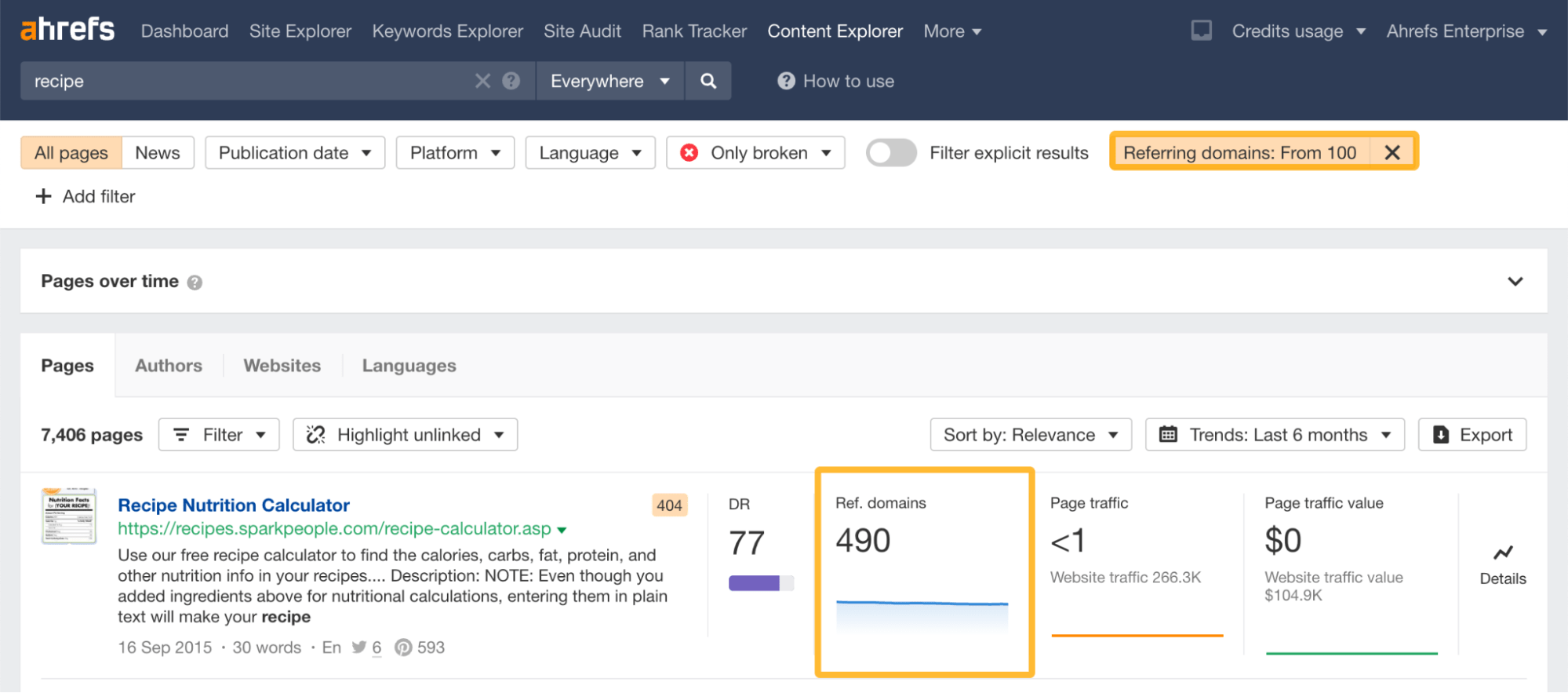
If we have a site in this niche, we can create a similar piece of content on our site, then ask everyone linking to the dead page to link to us instead.
That’s obviously not everything…
Ahrefs has many more unique features and data points.
Perhaps I should write a follow-up article and showcase more of the unique things that only Ahrefs can do. What do you think?
SEO
brightonSEO Live Blog

Hello everyone. It’s April again, so I’m back in Brighton for another two days of Being the introvert I am, my idea of fun isn’t hanging around our booth all day explaining we’ve run out of t-shirts (seriously, you need to be fast if you want swag!). So I decided to do something useful and live-blog the event instead.
Follow below for talk takeaways and (very) mildly humorous commentary. sun, sea, and SEO!
SEO
Google Further Postpones Third-Party Cookie Deprecation In Chrome

Google has again delayed its plan to phase out third-party cookies in the Chrome web browser. The latest postponement comes after ongoing challenges in reconciling feedback from industry stakeholders and regulators.
The announcement was made in Google and the UK’s Competition and Markets Authority (CMA) joint quarterly report on the Privacy Sandbox initiative, scheduled for release on April 26.
Chrome’s Third-Party Cookie Phaseout Pushed To 2025
Google states it “will not complete third-party cookie deprecation during the second half of Q4” this year as planned.
Instead, the tech giant aims to begin deprecating third-party cookies in Chrome “starting early next year,” assuming an agreement can be reached with the CMA and the UK’s Information Commissioner’s Office (ICO).
The statement reads:
“We recognize that there are ongoing challenges related to reconciling divergent feedback from the industry, regulators and developers, and will continue to engage closely with the entire ecosystem. It’s also critical that the CMA has sufficient time to review all evidence, including results from industry tests, which the CMA has asked market participants to provide by the end of June.”
Continued Engagement With Regulators
Google reiterated its commitment to “engaging closely with the CMA and ICO” throughout the process and hopes to conclude discussions this year.
This marks the third delay to Google’s plan to deprecate third-party cookies, initially aiming for a Q3 2023 phaseout before pushing it back to late 2024.
The postponements reflect the challenges in transitioning away from cross-site user tracking while balancing privacy and advertiser interests.
Transition Period & Impact
In January, Chrome began restricting third-party cookie access for 1% of users globally. This percentage was expected to gradually increase until 100% of users were covered by Q3 2024.
However, the latest delay gives websites and services more time to migrate away from third-party cookie dependencies through Google’s limited “deprecation trials” program.
The trials offer temporary cookie access extensions until December 27, 2024, for non-advertising use cases that can demonstrate direct user impact and functional breakage.
While easing the transition, the trials have strict eligibility rules. Advertising-related services are ineligible, and origins matching known ad-related domains are rejected.
Google states the program aims to address functional issues rather than relieve general data collection inconveniences.
Publisher & Advertiser Implications
The repeated delays highlight the potential disruption for digital publishers and advertisers relying on third-party cookie tracking.
Industry groups have raised concerns that restricting cross-site tracking could push websites toward more opaque privacy-invasive practices.
However, privacy advocates view the phaseout as crucial in preventing covert user profiling across the web.
With the latest postponement, all parties have more time to prepare for the eventual loss of third-party cookies and adopt Google’s proposed Privacy Sandbox APIs as replacements.
Featured Image: Novikov Aleksey/Shutterstock
SEO
How To Write ChatGPT Prompts To Get The Best Results

ChatGPT is a game changer in the field of SEO. This powerful language model can generate human-like content, making it an invaluable tool for SEO professionals.
However, the prompts you provide largely determine the quality of the output.
To unlock the full potential of ChatGPT and create content that resonates with your audience and search engines, writing effective prompts is crucial.
In this comprehensive guide, we’ll explore the art of writing prompts for ChatGPT, covering everything from basic techniques to advanced strategies for layering prompts and generating high-quality, SEO-friendly content.
Writing Prompts For ChatGPT
What Is A ChatGPT Prompt?
A ChatGPT prompt is an instruction or discussion topic a user provides for the ChatGPT AI model to respond to.
The prompt can be a question, statement, or any other stimulus to spark creativity, reflection, or engagement.
Users can use the prompt to generate ideas, share their thoughts, or start a conversation.
ChatGPT prompts are designed to be open-ended and can be customized based on the user’s preferences and interests.
How To Write Prompts For ChatGPT
Start by giving ChatGPT a writing prompt, such as, “Write a short story about a person who discovers they have a superpower.”
ChatGPT will then generate a response based on your prompt. Depending on the prompt’s complexity and the level of detail you requested, the answer may be a few sentences or several paragraphs long.
Use the ChatGPT-generated response as a starting point for your writing. You can take the ideas and concepts presented in the answer and expand upon them, adding your own unique spin to the story.
If you want to generate additional ideas, try asking ChatGPT follow-up questions related to your original prompt.
For example, you could ask, “What challenges might the person face in exploring their newfound superpower?” Or, “How might the person’s relationships with others be affected by their superpower?”
Remember that ChatGPT’s answers are generated by artificial intelligence and may not always be perfect or exactly what you want.
However, they can still be a great source of inspiration and help you start writing.
Must-Have GPTs Assistant
I recommend installing the WebBrowser Assistant created by the OpenAI Team. This tool allows you to add relevant Bing results to your ChatGPT prompts.
This assistant adds the first web results to your ChatGPT prompts for more accurate and up-to-date conversations.
It is very easy to install in only two clicks. (Click on Start Chat.)
For example, if I ask, “Who is Vincent Terrasi?,” ChatGPT has no answer.
With WebBrower Assistant, the assistant creates a new prompt with the first Bing results, and now ChatGPT knows who Vincent Terrasi is.
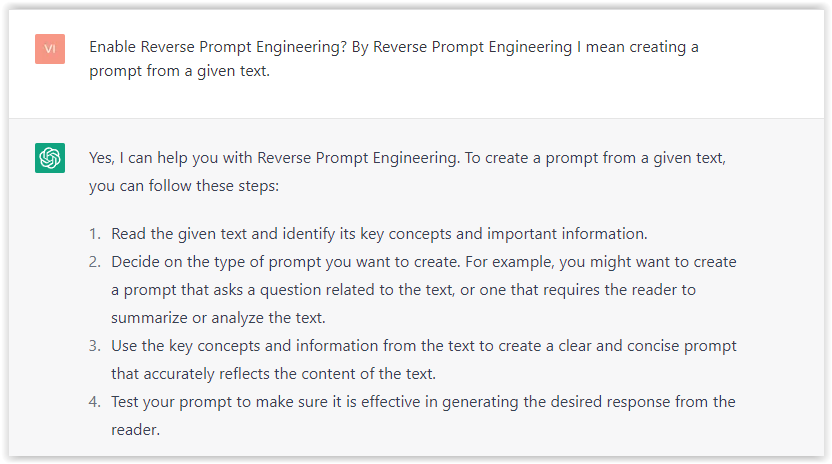 Screenshot from ChatGPT, March 2023
Screenshot from ChatGPT, March 2023You can test other GPT assistants available in the GPTs search engine if you want to use Google results.
Master Reverse Prompt Engineering
ChatGPT can be an excellent tool for reverse engineering prompts because it generates natural and engaging responses to any given input.
By analyzing the prompts generated by ChatGPT, it is possible to gain insight into the model’s underlying thought processes and decision-making strategies.
One key benefit of using ChatGPT to reverse engineer prompts is that the model is highly transparent in its decision-making.
This means that the reasoning and logic behind each response can be traced, making it easier to understand how the model arrives at its conclusions.
Once you’ve done this a few times for different types of content, you’ll gain insight into crafting more effective prompts.
Prepare Your ChatGPT For Generating Prompts
First, activate the reverse prompt engineering.
- Type the following prompt: “Enable Reverse Prompt Engineering? By Reverse Prompt Engineering I mean creating a prompt from a given text.”
 Screenshot from ChatGPT, March 2023
Screenshot from ChatGPT, March 2023ChatGPT is now ready to generate your prompt. You can test the product description in a new chatbot session and evaluate the generated prompt.
- Type: “Create a very technical reverse prompt engineering template for a product description about iPhone 11.”
 Screenshot from ChatGPT, March 2023
Screenshot from ChatGPT, March 2023The result is amazing. You can test with a full text that you want to reproduce. Here is an example of a prompt for selling a Kindle on Amazon.
- Type: “Reverse Prompt engineer the following {product), capture the writing style and the length of the text :
product =”
 Screenshot from ChatGPT, March 2023
Screenshot from ChatGPT, March 2023I tested it on an SEJ blog post. Enjoy the analysis – it is excellent.
- Type: “Reverse Prompt engineer the following {text}, capture the tone and writing style of the {text} to include in the prompt :
text = all text coming from https://www.searchenginejournal.com/google-bard-training-data/478941/”
 Screenshot from ChatGPT, March 2023
Screenshot from ChatGPT, March 2023But be careful not to use ChatGPT to generate your texts. It is just a personal assistant.
Go Deeper
Prompts and examples for SEO:
- Keyword research and content ideas prompt: “Provide a list of 20 long-tail keyword ideas related to ‘local SEO strategies’ along with brief content topic descriptions for each keyword.”
- Optimizing content for featured snippets prompt: “Write a 40-50 word paragraph optimized for the query ‘what is the featured snippet in Google search’ that could potentially earn the featured snippet.”
- Creating meta descriptions prompt: “Draft a compelling meta description for the following blog post title: ’10 Technical SEO Factors You Can’t Ignore in 2024′.”
Important Considerations:
- Always Fact-Check: While ChatGPT can be a helpful tool, it’s crucial to remember that it may generate inaccurate or fabricated information. Always verify any facts, statistics, or quotes generated by ChatGPT before incorporating them into your content.
- Maintain Control and Creativity: Use ChatGPT as a tool to assist your writing, not replace it. Don’t rely on it to do your thinking or create content from scratch. Your unique perspective and creativity are essential for producing high-quality, engaging content.
- Iteration is Key: Refine and revise the outputs generated by ChatGPT to ensure they align with your voice, style, and intended message.
Additional Prompts for Rewording and SEO:
– Rewrite this sentence to be more concise and impactful.
– Suggest alternative phrasing for this section to improve clarity.
– Identify opportunities to incorporate relevant internal and external links.
– Analyze the keyword density and suggest improvements for better SEO.
Remember, while ChatGPT can be a valuable tool, it’s essential to use it responsibly and maintain control over your content creation process.
Experiment And Refine Your Prompting Techniques
Writing effective prompts for ChatGPT is an essential skill for any SEO professional who wants to harness the power of AI-generated content.
Hopefully, the insights and examples shared in this article can inspire you and help guide you to crafting stronger prompts that yield high-quality content.
Remember to experiment with layering prompts, iterating on the output, and continually refining your prompting techniques.
This will help you stay ahead of the curve in the ever-changing world of SEO.
More resources:
Featured Image: Tapati Rinchumrus/Shutterstock
-

 PPC6 days ago
PPC6 days ago19 Best SEO Tools in 2024 (For Every Use Case)
-

 MARKETING7 days ago
MARKETING7 days agoEcommerce evolution: Blurring the lines between B2B and B2C
-
SEARCHENGINES5 days ago
Daily Search Forum Recap: April 19, 2024
-
SEARCHENGINES6 days ago
Daily Search Forum Recap: April 18, 2024
-

 WORDPRESS6 days ago
WORDPRESS6 days agoHow to Make $5000 of Passive Income Every Month in WordPress
-

 SEO7 days ago
SEO7 days ago2024 WordPress Vulnerability Report Shows Errors Sites Keep Making
-

 WORDPRESS6 days ago
WORDPRESS6 days ago10 Amazing WordPress Design Resouces – WordPress.com News
-

 SEO6 days ago
SEO6 days ago25 WordPress Alternatives Best For SEO
















You must be logged in to post a comment Login